Exhibit 99

| Edison Electric Institute Financial Conference Hollywood, Florida November 6-9, 2005 Exelon Corporation Public Service Enterprise Group |
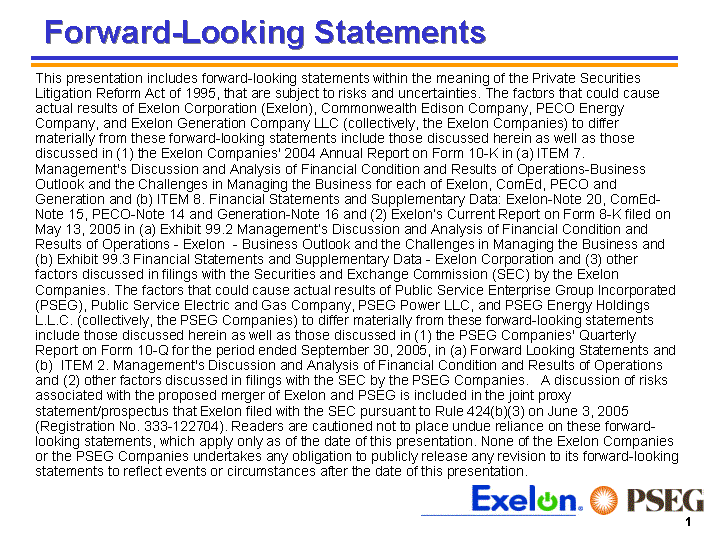
| Forward-Looking Statements This presentation includes forward-looking statements within the meaning of the Private Securities Litigation Reform Act of 1995, that are subject to risks and uncertainties. The factors that could cause actual results of Exelon Corporation (Exelon), Commonwealth Edison Company, PECO Energy Company, and Exelon Generation Company LLC (collectively, the Exelon Companies) to differ materially from these forward-looking statements include those discussed herein as well as those discussed in (1) the Exelon Companies' 2004 Annual Report on Form 10-K in (a) ITEM 7. Management's Discussion and Analysis of Financial Condition and Results of Operations-Business Outlook and the Challenges in Managing the Business for each of Exelon, ComEd, PECO and Generation and (b) ITEM 8. Financial Statements and Supplementary Data: Exelon-Note 20, ComEd- Note 15, PECO-Note 14 and Generation-Note 16 and (2) Exelon's Current Report on Form 8-K filed on May 13, 2005 in (a) Exhibit 99.2 Management's Discussion and Analysis of Financial Condition and Results of Operations - Exelon - Business Outlook and the Challenges in Managing the Business and (b) Exhibit 99.3 Financial Statements and Supplementary Data - Exelon Corporation and (3) other factors discussed in filings with the Securities and Exchange Commission (SEC) by the Exelon Companies. The factors that could cause actual results of Public Service Enterprise Group Incorporated (PSEG), Public Service Electric and Gas Company, PSEG Power LLC, and PSEG Energy Holdings L.L.C. (collectively, the PSEG Companies) to differ materially from these forward-looking statements include those discussed herein as well as those discussed in (1) the PSEG Companies' Quarterly Report on Form 10-Q for the period ended September 30, 2005, in (a) Forward Looking Statements and (b) ITEM 2. Management's Discussion and Analysis of Financial Condition and Results of Operations and (2) other factors discussed in filings with the SEC by the PSEG Companies. A discussion of risks associated with the proposed merger of Exelon and PSEG is included in the joint proxy statement/prospectus that Exelon filed with the SEC pursuant to Rule 424(b)(3) on June 3, 2005 (Registration No. 333-122704). Readers are cautioned not to place undue reliance on these forward- looking statements, which apply only as of the date of this presentation. None of the Exelon Companies or the PSEG Companies undertakes any obligation to publicly release any revision to its forward-looking statements to reflect events or circumstances after the date of this presentation. |

| Agenda Tom O'Flynn Executive VP and CFO Public Service Enterprise Group John Young Executive VP, Finance and Markets Exelon Corporation PSEG Overview 2005 Performance 2006 Outlook & Environment Merger Update Exelon Overview 2005 Performance 2006 Outlook & Environment Illinois Update |

| PSEG Overview - 2005 Electric Customers: 2.1M Gas Customers: 1.7M ~40% of Operating Earnings Nuclear Capacity: 3,484 MW Total Capacity: 14,549 MW ~45% of Operating Earnings ~15% of Operating Earnings Traditional T&D Leveraged Leases Operating Earnings(1): $770M - $810M EPS Guidance: $3.15 - $3.35 Assets (as of 9/30/05): $30B Domestic/Int'l Energy Regional Wholesale Energy (1) Includes the parent impact of $(65-75)M; Excludes Merger-related costs |
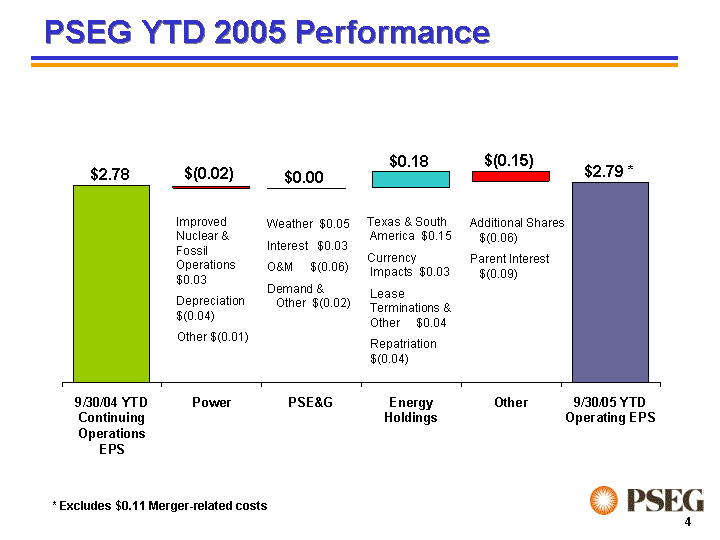
| 9/30/04 YTD Continuing Operations EPS Power PSE&G Energy Holdings Other 9/30/05 YTD Operating EPS West 720 715 715 716 730 0 0 3 0 35 21 725 PSEG YTD 2005 Performance Improved Nuclear & Fossil Operations $0.03 Depreciation $(0.04) Other $(0.01) Weather $0.05 Interest $0.03 O&M $(0.06) Demand & Other $(0.02) $2.79 * $2.78 Texas & South America $0.15 Currency Impacts $0.03 Lease Terminations & Other $0.04 Repatriation $(0.04) Additional Shares $(0.06) Parent Interest $(0.09) $(0.02) $0.00 $0.18 $(0.15) * Excludes $0.11 Merger-related costs |

| 2005 Key Events Natural Gas Price Impact Longer-term Benefits Liquidity Customer Impact Dampened - BGS: 3-year contracts - BGSS: storage and hedges Balance Sheet Liquidity - $2.1B as of 10/28 - $500M of New Facilities Cash - Waterford Sale - Securitization: Year 4 BGS - Repatriation Regulatory Gas Rate Case - $133M increase requested including $55M Depreciation Electric Proceeding - $64M Depreciation Credit Operations Nuclear - 2005 Projected Capacity: 88% vs. 2004: 82% - Salem 2 outage: 36 Days - Salem 1 progressing Fossil - 10% more MWh's YTD than last year - BEC & Lawrenceburg Operational - 21% improvement in Coal Capacity Factor |

| Attractive Pricing Environment PJM Western Hub (RTC) Forward Prices and NYMEX Natural Gas (Henry Hub) BGS Prices (NJ Avg -Approx) $32 - $33 $36 - $37 $44 - $46 PJM West RTC NYMEX (Henry Hub) $53 $55 $66 $5.15 - $5.35 $5.25 - $5.40 $6.50 - $6.65 RTC = round the clock |
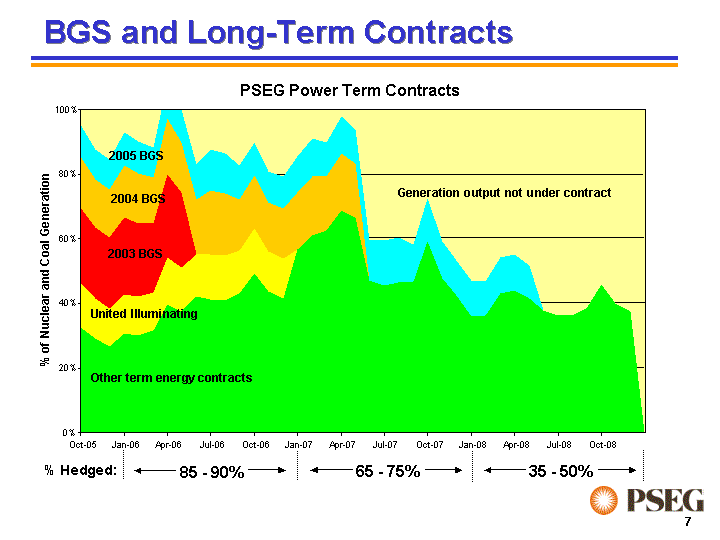
| BGS and Long-Term Contracts 0% 20% 40% 60% 80% 100% Oct-05 Jan-06 Apr-06 Jul-06 Oct-06 Jan-07 Apr-07 Jul-07 Oct-07 Jan-08 Apr-08 Jul-08 Oct-08 % of Nuclear and Coal Generation Generation output not under contract Other term energy contracts 2003 BGS United Illuminating 2004 BGS 2005 BGS PSEG Power Term Contracts 85 - 90% 65 - 75% 35 - 50% % Hedged: |
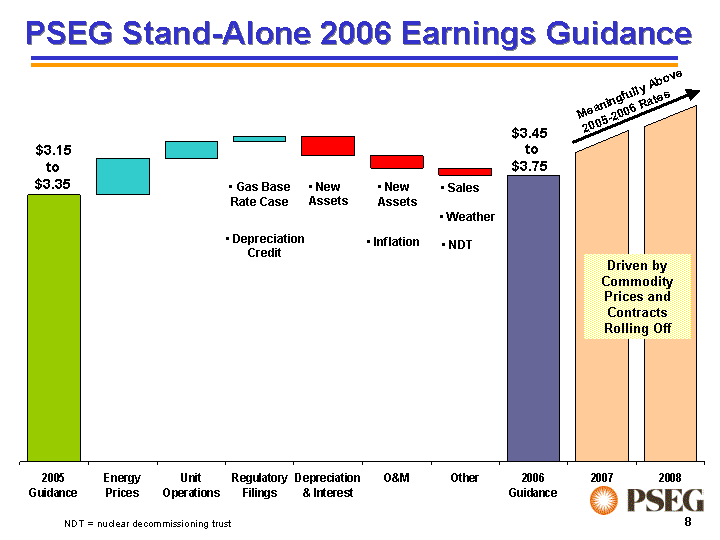
| 2005 Guidance Energy Prices Unit Operations Regulatory Filings Depreciation & Interest O&M Other 2006 Guidance 2007 2008 West 755 755 818 846 821 801 788 0 0 0 0 63 28 8 33 20 13 788 828 869.9 Meaningfully Above 2005-2006 Rates Gas Base Rate Case New Assets New Assets Sales Driven by Commodity Prices and Contracts Rolling Off Weather NDT Depreciation Credit Inflation $3.15 $3.35 to $3.45 $3.75 to PSEG Stand-Alone 2006 Earnings Guidance NDT = nuclear decommissioning trust |
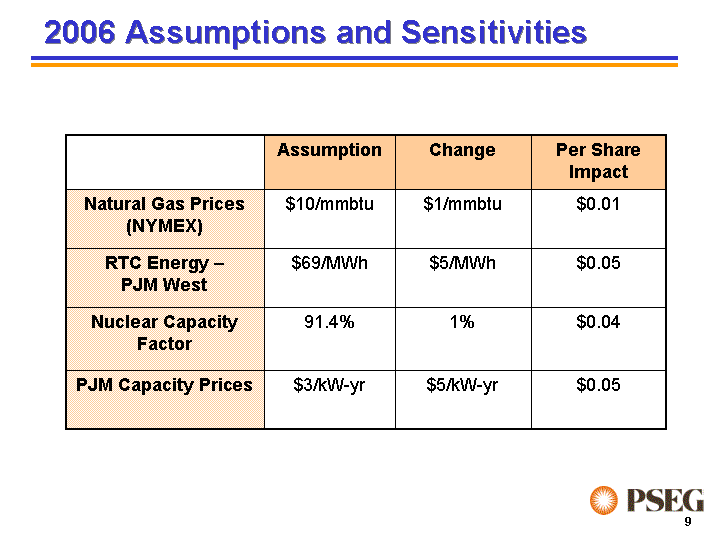
| 2006 Assumptions and Sensitivities Assumption Change Per Share Impact Natural Gas Prices (NYMEX) $10/mmbtu $1/mmbtu $0.01 RTC Energy - PJM West $69/MWh $5/MWh $0.05 Nuclear Capacity Factor 91.4% 1% $0.04 PJM Capacity Prices $3/kW-yr $5/kW-yr $0.05 |
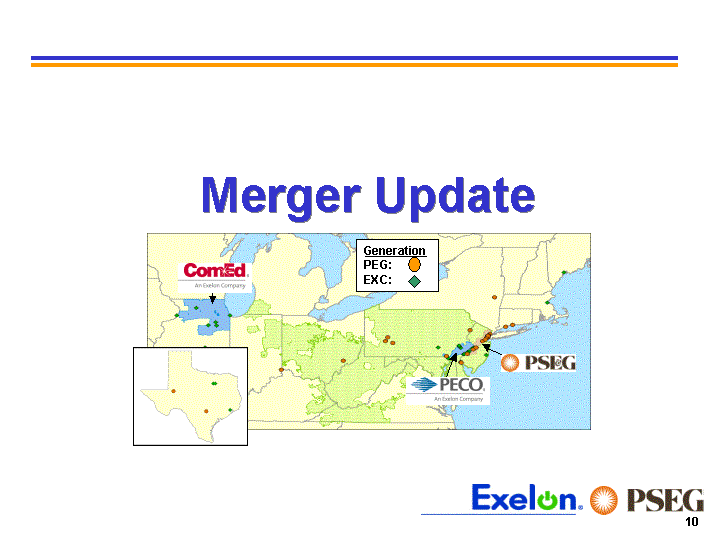
| Merger Update Generation PEG: EXC: |
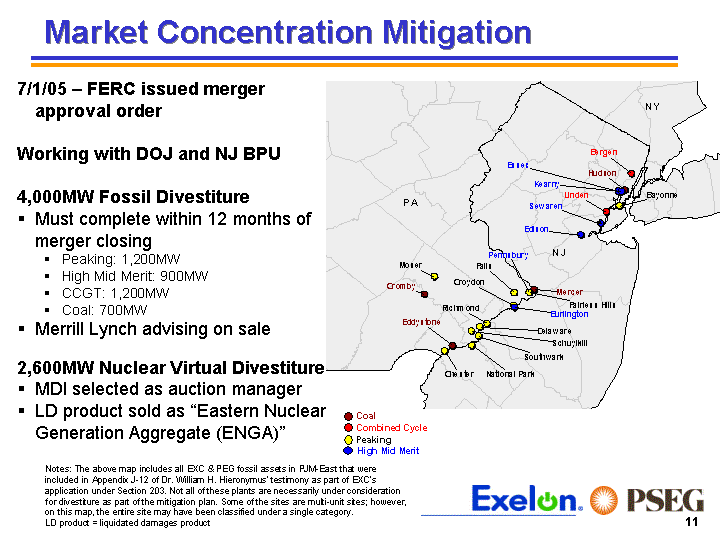
| Market Concentration Mitigation 7/1/05 - FERC issued merger approval order Working with DOJ and NJ BPU 4,000MW Fossil Divestiture Must complete within 12 months of merger closing Peaking: 1,200MW High Mid Merit: 900MW CCGT: 1,200MW Coal: 700MW Merrill Lynch advising on sale 2,600MW Nuclear Virtual Divestiture MDI selected as auction manager LD product sold as "Eastern Nuclear Generation Aggregate (ENGA)" Combined Cycle Peaking High Mid Merit Notes: The above map includes all EXC & PEG fossil assets in PJM-East that were included in Appendix J-12 of Dr. William H. Hieronymus' testimony as part of EXC's application under Section 203. Not all of these plants are necessarily under consideration for divestiture as part of the mitigation plan. Some of the sites are multi-unit sites; however, on this map, the entire site may have been classified under a single category. LD product = liquidated damages product |
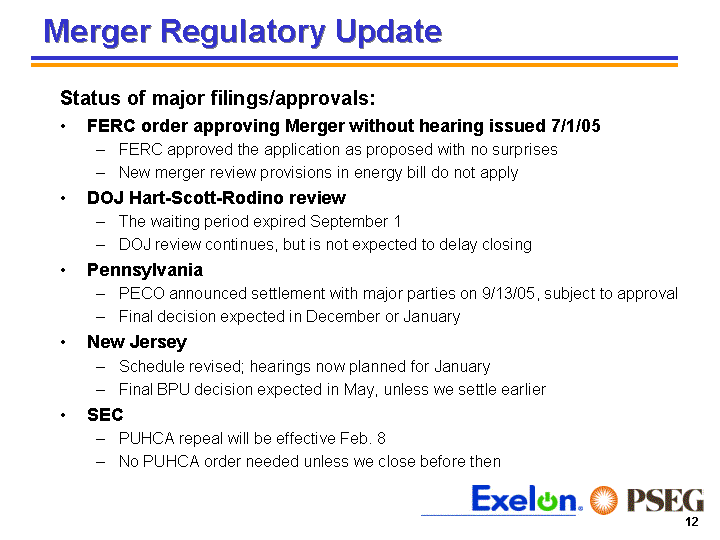
| Merger Regulatory Update Status of major filings/approvals: FERC order approving Merger without hearing issued 7/1/05 FERC approved the application as proposed with no surprises New merger review provisions in energy bill do not apply DOJ Hart-Scott-Rodino review The waiting period expired September 1 DOJ review continues, but is not expected to delay closing Pennsylvania PECO announced settlement with major parties on 9/13/05, subject to approval Final decision expected in December or January New Jersey Schedule revised; hearings now planned for January Final BPU decision expected in May, unless we settle earlier SEC PUHCA repeal will be effective Feb. 8 No PUHCA order needed unless we close before then |
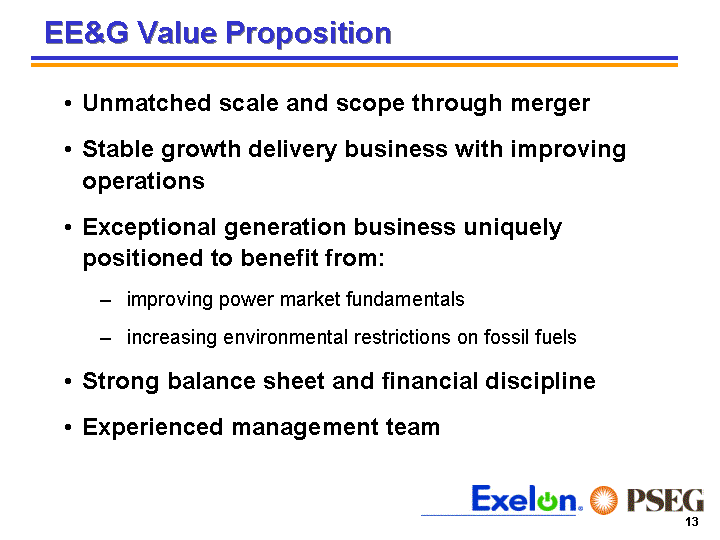
| Unmatched scale and scope through merger Stable growth delivery business with improving operations Exceptional generation business uniquely positioned to benefit from: improving power market fundamentals increasing environmental restrictions on fossil fuels Strong balance sheet and financial discipline Experienced management team EE&G Value Proposition |


| Exelon Overview - 2005 (1) Includes long-term contracts Note: See presentation appendix for adjusted (non-GAAP) operating reconciliations to GAAP 2005E Operating Earnings: $2.0-$2.1B EPS Guidance: $3.00-$3.15 Assets (9/30/05): $43B Pennsylvania Utility Illinois Utility Nuclear Generation Fossil Generation Power Marketing Nuclear Capacity: 16,900 MW Total Capacity: 33,700 MW(1) ~50% of Operating Earnings Electric Customers: 5.2M Gas Customers: 0.5M ~50% of Operating Earnings Traditional T&D Regional Wholesale Energy |
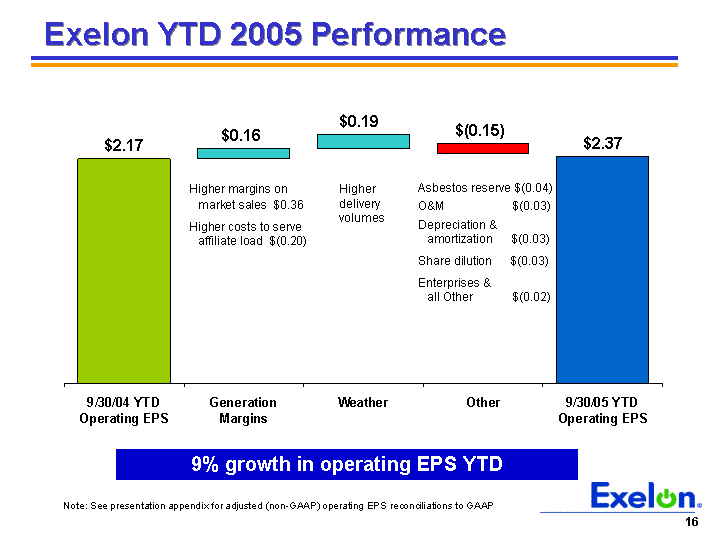
| 9/30/04 YTD Operating EPS Generation Margins Weather Other 9/30/05 YTD Operating EPS West 720 720 740 730 0 0 20 25 19 725 Higher margins on market sales $0.36 Higher costs to serve affiliate load $(0.20) $2.37 $2.17 Higher delivery volumes Asbestos reserve $(0.04) O&M $(0.03) Depreciation & amortization $(0.03) Share dilution $(0.03) Enterprises & all Other $(0.02) $0.16 $0.19 $(0.15) Exelon YTD 2005 Performance Note: See presentation appendix for adjusted (non-GAAP) operating EPS reconciliations to GAAP 9% growth in operating EPS YTD |
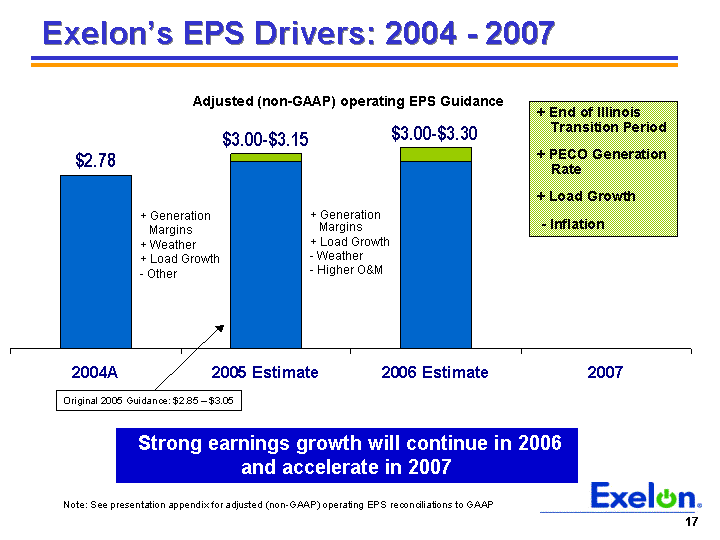
| 2004A 2005 Estimate 2006 Estimate 2007 East 2.78 3 3 0.125 0.24 $2.78 $3.00-$3.15 $3.00-$3.30 + Generation Margins + Weather + Load Growth - - Other Exelon's EPS Drivers: 2004 - 2007 + Generation Margins + Load Growth - - Weather - - Higher O&M + End of Illinois Transition Period + PECO Generation Rate + Load Growth - Inflation Note: See presentation appendix for adjusted (non-GAAP) operating EPS reconciliations to GAAP Original 2005 Guidance: $2.85 - $3.05 Strong earnings growth will continue in 2006 and accelerate in 2007 Adjusted (non-GAAP) operating EPS Guidance |
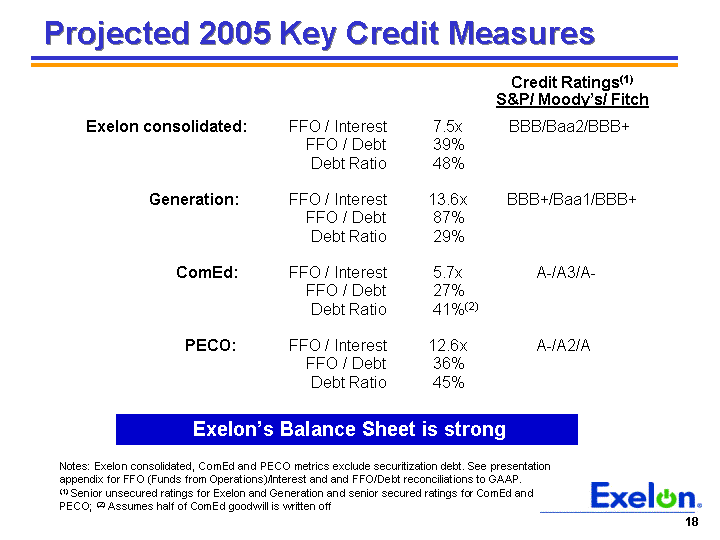
| Exelon consolidated: FFO / Interest 7.5x BBB/Baa2/BBB+ FFO / Debt 39% Debt Ratio 48% Generation: FFO / Interest 13.6x BBB+/Baa1/BBB+ FFO / Debt 87% Debt Ratio 29% ComEd: FFO / Interest 5.7x A-/A3/A- FFO / Debt 27% Debt Ratio 41%(2) PECO: FFO / Interest 12.6x A-/A2/A FFO / Debt 36% Debt Ratio 45% Notes: Exelon consolidated, ComEd and PECO metrics exclude securitization debt. See presentation appendix for FFO (Funds from Operations)/Interest and and FFO/Debt reconciliations to GAAP. (1) Senior unsecured ratings for Exelon and Generation and senior secured ratings for ComEd and PECO; (2) Assumes half of ComEd goodwill is written off Exelon's Balance Sheet is strong Credit Ratings(1) S&P/ Moody's/ Fitch Projected 2005 Key Credit Measures |
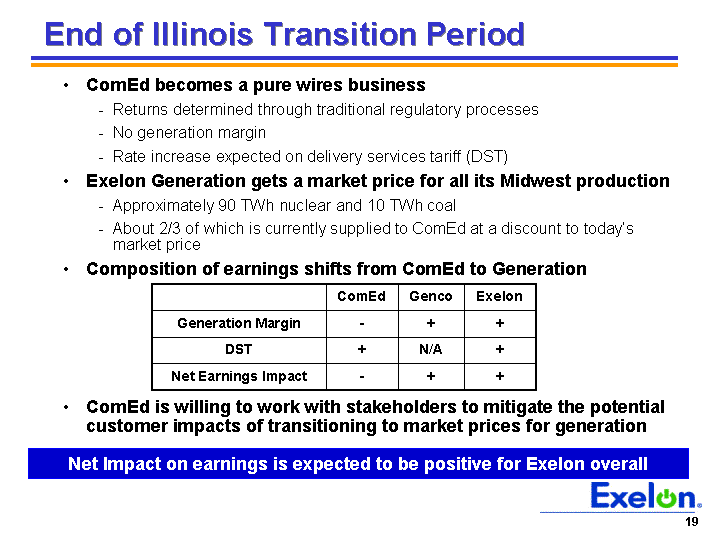
| ComEd becomes a pure wires business - - Returns determined through traditional regulatory processes - - No generation margin - - Rate increase expected on delivery services tariff (DST) Exelon Generation gets a market price for all its Midwest production - - Approximately 90 TWh nuclear and 10 TWh coal - - About 2/3 of which is currently supplied to ComEd at a discount to today's market price Composition of earnings shifts from ComEd to Generation ComEd is willing to work with stakeholders to mitigate the potential customer impacts of transitioning to market prices for generation Net Impact on earnings is expected to be positive for Exelon overall ComEd Genco Exelon Generation Margin - + + DST + N/A + Net Earnings Impact - + + End of Illinois Transition Period |

| 2002 2003 2004 2005E 2006E 2007* Generation 0.24 0.3 0.33 0.5 0.51 0.7 ComEd 0.47 0.45 0.42 0.26 0.27 0.14 PECO 0.29 0.25 0.25 0.24 0.22 0.16 A further shift in relative earnings contribution from Energy Delivery to Generation will occur in 2007 when ComEd becomes a pure wires company and Generation gets a market price for its Midwest production Composition of Operating Earnings * Based on Thomson First Call consensus EPS estimate of $4.20 |
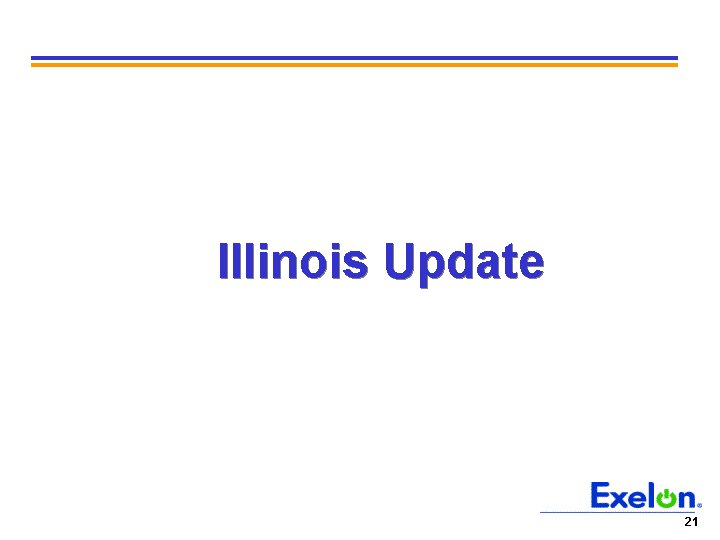

| 1997 Illinois Restructuring Act The Illinois Restructuring Act has benefited both customers and shareholders Consumers have benefited: Since 1997, ComEd residential electric rates have been reduced 20% and frozen through the end of 2006 As a result, residential customers will have enjoyed $4 billion in savings during this period Competition has developed: More than 50% of large customer load >1 MW served by retail energy suppliers 23.5% of ComEd's total load served by retail energy suppliers 18 suppliers certified by the Illinois Commerce Commission Eight suppliers serving 20,000 GWh load Exelon has restructured: As a result of the 1997 Act, the company was separated into two businesses We have used the restructuring and transition period to improve both delivery and generation businesses Invested $3 billion in T&D infrastructure over past 5 years for improved reliability Nuclear capacity factor has risen to 93+% and nuclear production costs are down from $26.80 per MWh at ComEd in 1997 to $12.43 per MWh fleet wide in 2004 |
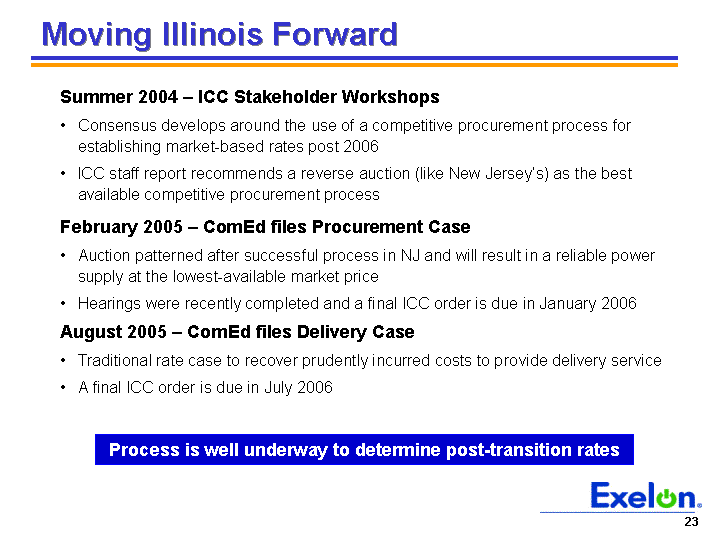
| Moving Illinois Forward Summer 2004 - ICC Stakeholder Workshops Consensus develops around the use of a competitive procurement process for establishing market-based rates post 2006 ICC staff report recommends a reverse auction (like New Jersey's) as the best available competitive procurement process February 2005 - ComEd files Procurement Case Auction patterned after successful process in NJ and will result in a reliable power supply at the lowest-available market price Hearings were recently completed and a final ICC order is due in January 2006 August 2005 - ComEd files Delivery Case Traditional rate case to recover prudently incurred costs to provide delivery service A final ICC order is due in July 2006 Process is well underway to determine post-transition rates |
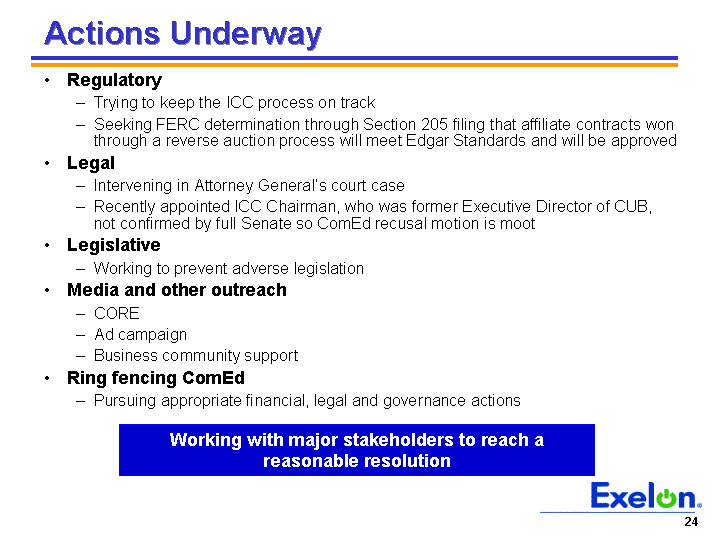
| Actions Underway Regulatory Trying to keep the ICC process on track Seeking FERC determination through Section 205 filing that affiliate contracts won through a reverse auction process will meet Edgar Standards and will be approved Legal Intervening in Attorney General's court case Recently appointed ICC Chairman, who was former Executive Director of CUB, not confirmed by full Senate so ComEd recusal motion is moot Legislative Working to prevent adverse legislation Media and other outreach CORE Ad campaign Business community support Ring fencing ComEd Pursuing appropriate financial, legal and governance actions Working with major stakeholders to reach a reasonable resolution |
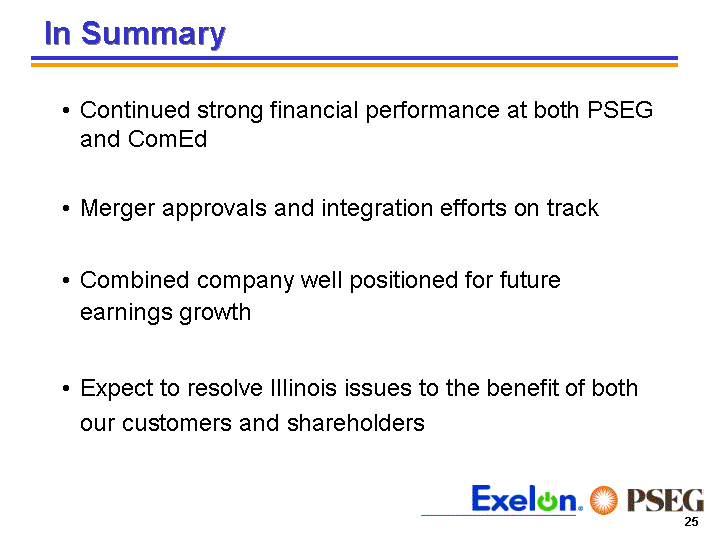
| In Summary Continued strong financial performance at both PSEG and ComEd Merger approvals and integration efforts on track Combined company well positioned for future earnings growth Expect to resolve Illinois issues to the benefit of both our customers and shareholders |
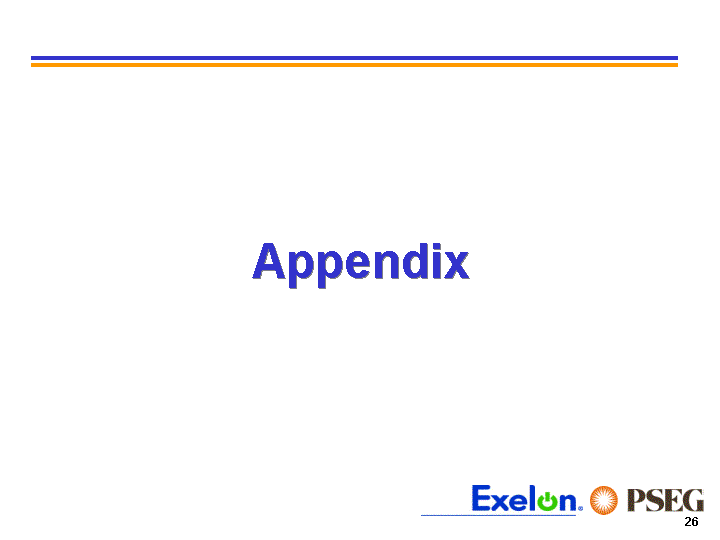
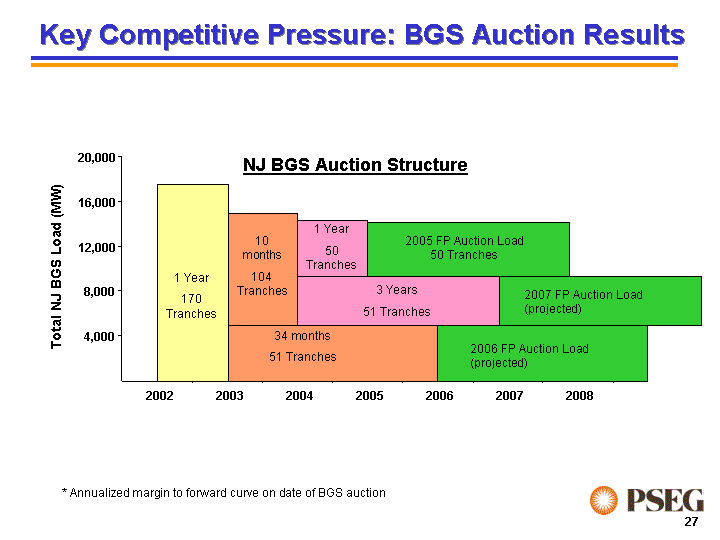
| 20,000 4,000 8,000 12,000 16,000 2002 2003 2004 2005 2006 2007 2008 1 Year 170 Tranches 10 months 104 Tranches 34 months 51 Tranches 1 Year 50 Tranches 3 Years 51 Tranches 2006 FP Auction Load (projected) 2005 FP Auction Load 50 Tranches 2007 FP Auction Load (projected) Total NJ BGS Load (MW) NJ BGS Auction Structure * Annualized margin to forward curve on date of BGS auction Key Competitive Pressure: BGS Auction Results |

| 2005 BGS Auction Results 2003 Auction 2004 Auction 2005 Auction East 32.1 36.9 45.14 West 20.6 17.55 20.77 $32 - $33 $36 -$37 $52.70 (10 Month NJ Avg.) $54.45 (12 Month NJ Avg.) $65.91 (36 Month NJ Avg.) $44 -$46 Transmission Ancillary services Load shape Congestion Risk premium Capacity ~ $20 ~ $18 ~ $21 RTC Forward Energy Cost RTC = round the clock |
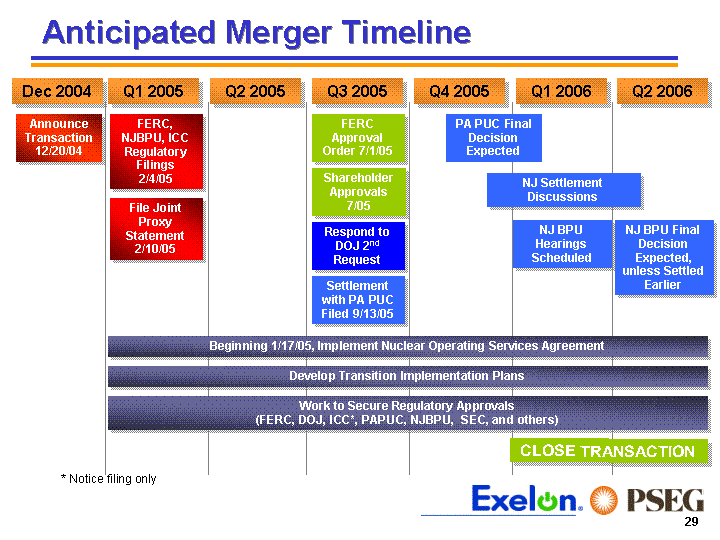
| Dec 2004 Q1 2005 Q2 2005 Q3 2005 Q4 2005 Q1 2006 Announce Transaction 12/20/04 Shareholder Approvals 7/05 FERC, NJBPU, ICC Regulatory Filings 2/4/05 File Joint Proxy Statement 2/10/05 Work to Secure Regulatory Approvals (FERC, DOJ, ICC*, PAPUC, NJBPU, SEC, and others) Develop Transition Implementation Plans CLOSE TRANSACTION Beginning 1/17/05, Implement Nuclear Operating Services Agreement Q2 2006 * Notice filing only FERC Approval Order 7/1/05 Respond to DOJ 2nd Request Settlement with PA PUC Filed 9/13/05 NJ BPU Hearings Scheduled NJ BPU Final Decision Expected, unless Settled Earlier PA PUC Final Decision Expected Anticipated Merger Timeline NJ Settlement Discussions |
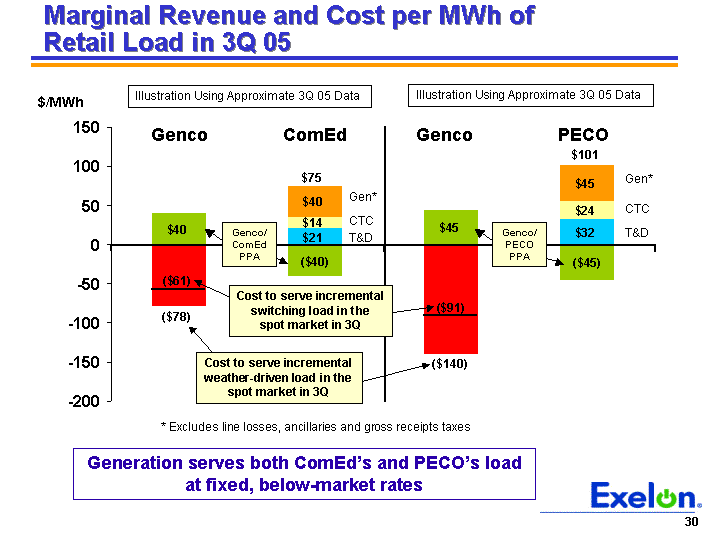
| Marginal Revenue and Cost per MWh of Retail Load in 3Q 05 ExGen ComEd ExGen PECO 40 21 45 32 -78 14 -140 24 40 45 -40 -45 $/MWh Genco/ ComEd PPA Cost to serve incremental weather-driven load in the spot market in 3Q Genco ComEd PECO Illustration Using Approximate 3Q 05 Data Genco Generation serves both ComEd's and PECO's load at fixed, below-market rates Genco/ PECO PPA Illustration Using Approximate 3Q 05 Data $75 $101 Gen* CTC T&D Gen* CTC T&D * Excludes line losses, ancillaries and gross receipts taxes Cost to serve incremental switching load in the spot market in 3Q ($78) ($140) |

| Higher Sales to ComEd $/MWh ComEd Genco Exelon Weather Revenue 75 40 75 Cost* (40) (78) (78) Margin 35 (38) (3) Switching Revenue 40 40 40 Cost* (40) (61) (61) Margin -- (21) (21) Warm summer weather was favorable for Delivery but unfavorable for Generation and Exelon overall Higher customer retention was neutral for Delivery and unfavorable for Generation and Exelon Overall Illustration Using Approximate 3Q 05 Data: Higher Sales to PECO $/MWh PECO Genco Exelon Weather Revenue 101 45 101 Cost* (45) (140) (140) Margin 56 (95) (39) Switching Revenue 45 45 45 Cost* (45) (91) (91) Margin -- (46) (46) Profit Impact of Higher Sales at ComEd and PECO in 3Q 05 * Cost to serve incremental load in spot market |
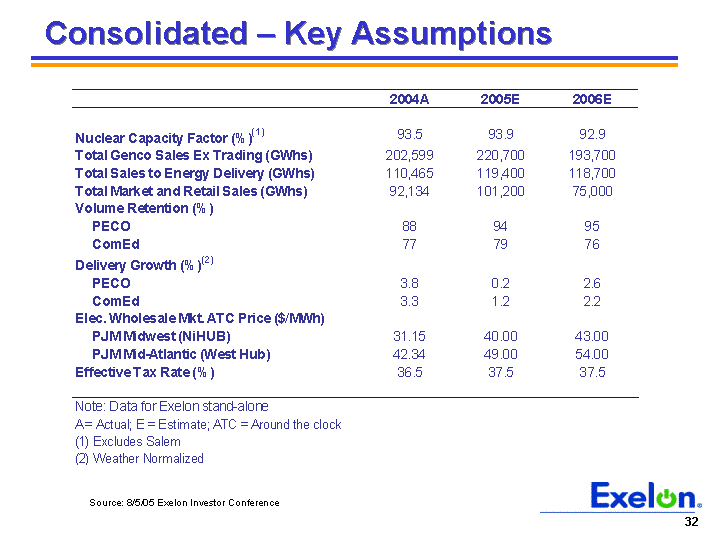
| Consolidated - Key Assumptions Source: 8/5/05 Exelon Investor Conference |
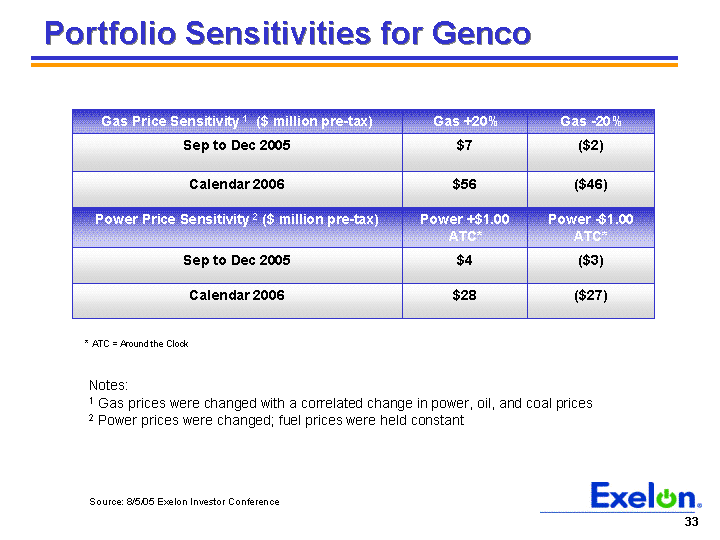
| Portfolio Sensitivities for Genco * ATC = Around the Clock Gas Price Sensitivity 1 ($ million pre-tax) Gas +20% Gas -20% Sep to Dec 2005 $7 ($2) Calendar 2006 $56 ($46) Power Price Sensitivity 2 ($ million pre-tax) Power +$1.00 ATC* Power -$1.00 ATC* Sep to Dec 2005 $4 ($3) Calendar 2006 $28 ($27) Notes: 1 Gas prices were changed with a correlated change in power, oil, and coal prices 2 Power prices were changed; fuel prices were held constant Source: 8/5/05 Exelon Investor Conference |
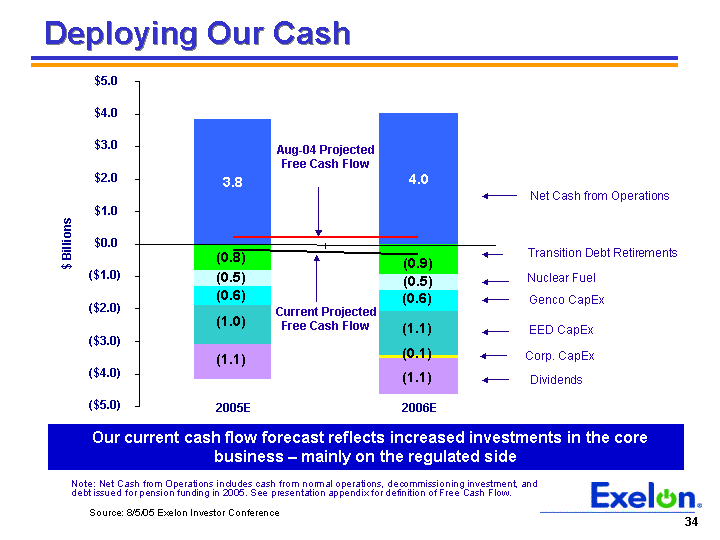
| Note: Net Cash from Operations includes cash from normal operations, decommissioning investment, and debt issued for pension funding in 2005. See presentation appendix for definition of Free Cash Flow. 3.8 4.0 (0.8) (0.9) (0.5) (0.5) (0.6) (0.6) (1.0) (1.1) (1.1) (1.1) ($5.0) ($4.0) ($3.0) ($2.0) ($1.0) $0.0 $1.0 $2.0 $3.0 $4.0 $5.0 2005E 2006E $ Billions Net Cash from Operations Dividends Transition Debt Retirements EED CapEx Genco CapEx Nuclear Fuel Aug-04 Projected Free Cash Flow Current Projected Free Cash Flow Our current cash flow forecast reflects increased investments in the core business - mainly on the regulated side (0.1) Corp. CapEx Deploying Our Cash Source: 8/5/05 Exelon Investor Conference |

| Note: Items may not add due to rounding. (in Millions, except EPS) Exelon Consolidated GAAP Earnings to Adjusted (non-GAAP) Operating Earnings - YTD through Sept. |
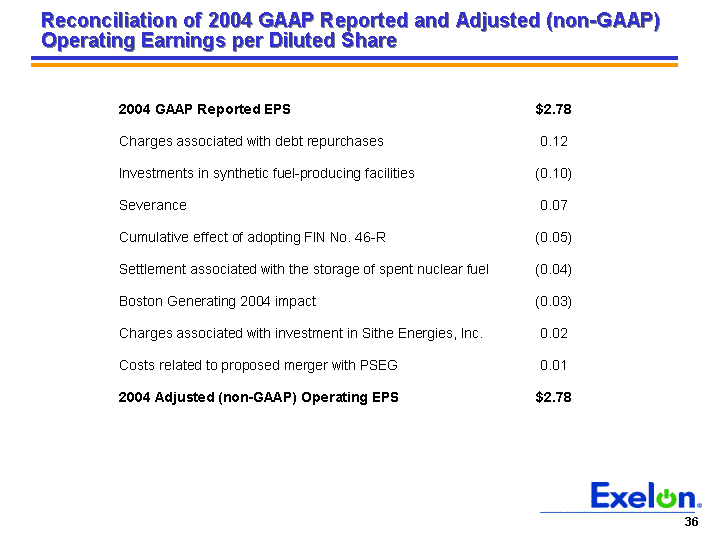
| Reconciliation of 2004 GAAP Reported and Adjusted (non-GAAP) Operating Earnings per Diluted Share |
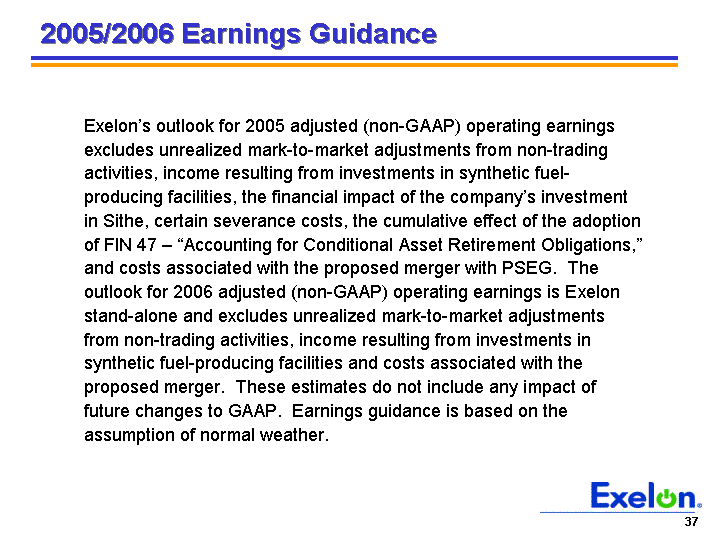
| 2005/2006 Earnings Guidance Exelon's outlook for 2005 adjusted (non-GAAP) operating earnings excludes unrealized mark-to-market adjustments from non-trading activities, income resulting from investments in synthetic fuel- producing facilities, the financial impact of the company's investment in Sithe, certain severance costs, the cumulative effect of the adoption of FIN 47 - "Accounting for Conditional Asset Retirement Obligations," and costs associated with the proposed merger with PSEG. The outlook for 2006 adjusted (non-GAAP) operating earnings is Exelon stand-alone and excludes unrealized mark-to-market adjustments from non-trading activities, income resulting from investments in synthetic fuel-producing facilities and costs associated with the proposed merger. These estimates do not include any impact of future changes to GAAP. Earnings guidance is based on the assumption of normal weather. |

| Cash Flow Definition We define free cash flow as: Cash from operations (which includes pension contributions and the benefit of synthetic fuel investments), Cash used in investing activities, Debt issued for pension funding, Cash used for transition debt maturities, Common stock dividend payments, Other routine activities (e.g., severance payments, system integration costs, tax effect of discretionary items, etc.) and cash flows from divested operations |
FFO Calculation and Ratios
Net Income
Add back non-cash items:
+ Depreciation, amortization (including nucl fuel amortization), AFUDC/Cap Int
+ Change in Deferred Taxes
+ Gain on Sale and Extraordinary Items
+ Trust-Preferred Interest Expense
– Transition Bond Principal Paydown
FFO
FFO Interest Coverage
FFO + Adjusted Interest
Adjusted Interest
Net Interest Expense (Before AFUDC & Cap Interest)
– Trust-Preferred Interest Expense
– Transition Bond Interest Expense
+ 10% of PV of Operating Leases
Adjusted Interest
FFO Debt Coverage
FFO
Adjusted Average Debt (1)
Debt:
LTD
STD
– Transition Bond Principal Balance
Add debt equivalents:
+ A/R Financing
+ PV of Operating Leases
Adjusted Debt
| | |
| (1) | | Use average of prior year and current year adjusted debt balance |
Debt to Total Cap
Adjusted Book Debt
Total Adjusted Capitalization
Debt:
LTD
STD
– Transition Bond Principal Balance
Adjusted Book Debt
Capitalization:
Total Shareholders’ Equity
Preferred Securities of Subsidiaries
Adjusted Book Debt
Total Adjusted Capitalization
Note: FFO and Debt related to non-recourse debt are excluded from the calculations.
ComEd Case Schedules
Procurement Case (# 05-0159: www.icc.illinois.gov):
• Filed February 2005
• June – Staff and Intervenor testimony
• Early July – ComEd rebuttal
• Early August – Staff and Intervenor rebuttals
• Late August-early September – Hearings
• October – Initial and Reply briefs
• Mid-to-late November – ALJ proposed order
• Late January 2006 – ICC order
Delivery Service Case (# 05-0597)
• Filed August 31, 2005
• December 23 – Staff and Intervenor direct testimony
• January 30, 2006 – ComEd Rebuttal
• February 27 – Staff and Intervenor rebuttal
• March 14 – ComEd surrebuttal
• March 17 – Pre-trial motions
• March 21-29 – Hearings
• April 25 – Initial briefs
• May 11 – Reply briefs
• June 8 – ALJ proposed order
• Late July – ICC order
IL Attorney General’s Circuit Court of Cook County Case (# 05-CH14914)
• September 1, 2005 – AG, CUB, Cook County State’s Attorney’s Office and Environmental Law and Public Policy Center filed two-count complaint against ICC
• October 12 – ICC, ComEd and Ameren filed opening briefs
• November 9 – Response by other parties
• December 14 – Hearing
• Late December – Judge’s ruling expected
FERC Application of ComEd and Exelon Generation under Section 205 of the Federal Power Act (Docket # ER06-43-000: www.ferc.gov)
• Filed October 17
• Expedited decision requested by December 15, 2005
EXC-PSEG Merger Case Schedules
NJ (Docket # EM05020106: www.bpu.state.nj.us)
• Filed February 4, 2005
• August 29 – Discovery on the Petitioners testimony
• November 14 – Ratepayer Advocate, BPU Staff & Intervenors testimony
• November 28 – Petitioners rebuttal testimony to Ratepayer Advocate, BPU Staff & Intervenors
• December 12-15 – Settlement discussion begins
• December 27 – Ratepayer Advocate, BPU Staff & Intervenor surrebuttal testimony
• January 2006 (12 days) – Evidentiary hearings
• January 23 – Settlement discussion continues
• February 3 – Filing of initial briefs
• February 17 – Filing of reply briefs
• March 30* – Initial ALJ decision
• May 15* – Final BPU decision and order
* Proposed dates based on the NJ Administrative Procedure Act
PA (Docket # A-110550F0160: www.puc.state.pa.us)
• Filed February 4, 2005
• May 1 – Initial discovery request period ends
• June 28 – Non-applicant parties, direct testimony
• June 29 – All parties, rebuttal testimony
• June 20 – Hearing to receive public comment
• August 26 – All parties, surrebuttal testimony
• September – Hearings
• September 13 – Partial settlement filed with the PUC
• October – Main briefs
• November – Reply briefs
• By mid-December – ALJ initial decision expected
• December 2005-early 2006 – Final PUC decision expected
Section 5/16-103
(220 ILCS 5/16-103)
Sec. 16-103. Service obligations of electric utilities.
(a) An electric utility shall continue offering to retail customers each tariffed service that it offered as a distinct and identifiable service on the effective date of this amendatory Act of 1997 until the service is (i) declared competitive pursuant toSection 16-113, or (ii) abandoned pursuant to Section 8-508. Nothing in this subsection shall be construed as limiting an electric utility’s right to propose, or the Commission’s power to approve, allow or order modifications in the rates, terms and conditions for such ser- vices pursuant to Article IX or Section 16-111 of this Act.
(b) An electric utility shall also offer, as tariffed services, delivery services in accordance with this Article, the power purchase options described in Section 16-110 and real-time pricing as provided in Section 16-107.
(c) Notwithstanding any other provision of this Article, each electric utility shall continue offering to all residential customers and to all small commercial retail customers in its service area, as a tariffed service, bundled electric power and energy delivered to the customer’s premises consistent with the bundled utility service provided by the electric utility on the effective date of this amendatory Act of 1997. Upon declaration of the provision of electric power and energy as competitive, the electric utility shall continue to offer to such customers, as a tariffed service, bundled service options at rates which reflect recovery of all cost components for providing the service. For those components of the service which have been declared competitive, cost shall be the market based prices. Market based prices as referred to herein shall mean, for electric power and energy, either (i) those prices for electric power and energy determined as provided in Section 16-112, or (ii) the electric utility’s cost of obtaining the electric power and energy at wholesale through a competitive bidding or other arms length acquisition process.
(d) Any residential or small commercial retail customer which elects delivery services is entitled to return to the electric utility’s bundled utility tariffed service offering provided in accordance with subsection (c) of this Section upon payment of a reasonable administrative fee which shall be set forth in the tariff, provided, however, that the electric utility shall be entitled to impose the condition that such customer may not elect delivery services for up to 24 months thereafter.
(e) The Commission shall not require an electric utility to offer any tariffed service other than the services required by this Section, and shall not require an electric utility to offer any competitive service.
(Source: P.A. 90-561, effective December 16, 1997)
Section 5/16-111
electric power or energy provided by the electric utility determined as set forth in the electric utility’s tariff for that customer’s class. The electric utility may require that the delivery services customer give up to 30 days notice for such a purchase.
(e) Each delivery services customer purchasing electric power and energy from the electric utility pursuant to a tariff filed in accordance with this Section shall also pay all of the applicable charges set forth in the electric utility’s delivery services tariffs and any other tariffs applicable to the services provided to that customer by the electric utility.
(f) An electric utility can require a retail customer taking delivery services that formerly generated electric power and energy for its own use and that would not otherwise pay transition charges on a portion of its electric power and energy requirements served on delivery services to pay transition charges on that portion of the customer’s electric power and energy requirements as a condition of exercising the delivery services customer power purchase options set forth in this Section.
(Source: P.A. 91-50, effective June 30, 1999)
(220 ILCS 5/16-111)
Sec. 16-111. Rates and restructuring transactions during mandatory transition period.
(a) During the mandatory transition period, notwithstanding any provision of Article IX of this Act, and except as provided in subsections (b), (d), (e), and (f) of this Section, the Commission shall not (i) initiate, authorize or order any change by way of increase (other than in connection with a request for rate increase which was filed after September 1, 1997 but prior to October 15, 1997, by an electric utility serving less than 12,500 customers in this state), (ii) initiate or, unless requested by the electric utility, authorize or order any change by way of decrease, restructuring or unbundling (except as provided inSection 16-109A), in the rates of any electric utility that were in effect on October 1, 1996, or (iii) in any order approving any application for a merger pursuant to Section 7-204 that was pending as of May 16, 1997, impose any condition requiring any filing for an increase, decrease, or change in, or other review of, an electric utility’s rates or enforce any such condition of any such order; provided, however, that this subsection shall not prohibit the Commission from:
(1) approving the application of an electric utility to implement an alternative to rate of return regulation or a regulatory mechanism that rewards or penalizes the electric utility through adjustment of rates based on utility performance, pursuant to Section 9-244;
(2) authorizing an electric utility to eliminate its fuel adjustment clause and adjust its base rate tariffs in accordance with subsection (b), (d), or (f) of Section 9-220 of this Act, to fix its fuel adjustment factor in accordance with sub
270
Section 5/16-111
services pursuant to Section 9-201, 9-202, 9-250 or 16-111 (d) of this Act, the Commission may establish new rates of depreciation for the electric utility in the same manner provided in subsection (d) of Section 5-104 of this Act. An electric utility implementing an accelerated cost recovery method including accelerated depreciation, accelerated amortization or other capital recovery methods, or recording reductions to the original cost of its assets, pursuant to subsection (g) of this Section, shall file a statement with the Commission describing the accelerated cost recovery method to be implemented or the reduction in the original cost of its assets to be recorded. Upon the filing of such statement, the accelerated cost recovery method or the reduction in the original cost of assets shall be deemed to be approved by the Commission as though an order had been entered by the Commission.
(i) Subsequent to the mandatory transition period, the Commission, in any proceeding to establish rates and charges for tariffed services offered by an electric utility, shall consider only (1) the then current or projected revenues, costs, investments and cost of capital directly or indirectly associated with the provision of such tariffed services; (2) collection of transition charges in accordance with Sections 16-102 and 16-108 of this Act; (3) recovery of any employee transition costs as described in Section 16-128 which the electric utility is continuing to incur, including recovery of any unamortized portion of such costs previously incurred or committed, with such costs to be equitably allocated among bundled services, delivery services, and contracts with alternative retail electric suppliers; and (4) recovery of the costs associated with the electric utility’s compliance with decommissioning funding requirements; and shall not consider any other revenues, costs, investments or cost of capital of either the electric utility or of any affiliate of the electric utility that are not associated with the provision of tariffed services. In setting rates for tariffed services, the Commission shall equitably allocate joint and common costs and investments between the electric utility’s competitive and tariffed services. In determining the justness and reasonableness of the electric power and energy component of an electric utility’s rates for tariffed services subsequent to the mandatory transition period and prior to the time that the provision of such electric power and energy is declared competitive, the Commission shall consider the extent to which the electric utility’s tariffed rates for such component for each customer class exceed the market value determined pursuant to Section 16-112, and, if the electric power and energy component of such tariffed rate exceeds the market value by more than 10% for any customer class, may establish such electric power and energy component at a rate equal to the market value plus 10%. In any such case, the Commission may also elect to extend the provisions of Section 16-111 (e) for any period in which the electric utility is collecting transition charges, using information applicable to such period.
(j) During the mandatory transition period, an electric utility may elect to transfer to a non-operating income account under the Commission’s Uniform System of Accounts either or both of (i) an amount of unamortized investment tax credit that is in addition to the ratable amount which is credited to the electric utility’s operating income account for the year in accordance with Section 46(f)(2) of the federal Internal Revenue Code of 1986, as in effect prior to P.L. 101-508, or (ii) “excess tax reserves”, as that
279
Section 5/16-112
(b) That, in light of the findings in paragraphs (1) and (2) of subsection (a) and, in this instance, the circumstances described in paragraphs (3) through (6) of subsection (a) and otherwise, the General Assembly hereby finds that allowing the generating facilities being acquired to be eligible facilities under the provisions of the National Energy Policy Act of 1992 that apply to exempt wholesale generators (A) will benefit consumers; (B) is in the public interest; and (C) does not violate the law of this State.
(c) Nothing in this Section shall have any effect on the authority of the Commission under subsection (g) of Section 16-111 of this Act.
(Source: P.A. 91-50, effective June 30, 1999)
(220 ILCS 5/16-111.3 new)
Sec. 16-111.3. Transition period earnings calculations. At such time as the Board of Governors of the Federal Reserve System ceases to include the monthly average yields of 30-year U.S. Treasury bonds in its weekly H.15 Statistical Release or successor publication, the Monthly Treasury Long-Term Average Rates (25 years and above) published by the Board of Governors of the Federal Reserve System in its weekly H.15 Statistical Release or successor publication shall instead be used to establish a rate for the purpose of calculating the Index defined in subsection (e) of Section 16-111 of this Act, and at such time, such Monthly Treasury Long-Term Average Rates (25 years and above) shall also be used in place of the monthly average yields of 30-year U.S. Treasury bonds in the rate of return calculation required by subsection (d) of Section 16-111. An electric utility shall also remove the effects, if any, of any impairment due to the application of Statement of Financial Accounting Standards No. 142, which was issued in June 2001, when making the calculations required by this State or by subsections (d) and (E) ofSection 16-111.
Source: P.A. 52-0537, effective June 6, 2002.
(220 ILCS 5/16-112)
Sec. 16-112. Determination of market value.
(a) The market value to be used in the calculation of transition charges as defined in Section 16-102 shall be determined in accordance with either (i) a tariff that has been filed by the electric utility with the Commission pursuant to Article IX of this Act and that provides for a determination of the market value for electric power and energy as a function of an exchange traded or other market traded index, options or futures contract or contracts applicable to the market in which the utility sells, and the customers in its service area buy, electric power and energy, or (ii) in the event no such tariff has been placed into effect for the electric utility, or in the event such tariff does not establish market values for each of the years specified in the neutral fact-finder
285
The Illinois Commerce Commission has the legal authority to approve an auction
September 8, 2005
The suit filed in circuit court challenging the Illinois Commerce Commission’s authority to approve an auction for the procurement of wholesale energy is without legal merit.
| | • | | Because ComEd no longer owns generation, it proposes to hold an open competitive auction in which the lowest bidding suppliers would supply the requirements of ComEd’s customers. Customers would be charged ComEd’s cost of buying the power, without any mark-up. |
| |
| | • | | The ICC is engaged in a thorough evidentiary review of ComEd’s proposal, which the suit seeks to halt. The plaintiffs made the same arguments to the ICC and asked it to dismiss the case. The Administrative Law Judge (ALJ) appointed by the ICC denied the request, and the ICC affirmed his ruling 5-0. |
| |
| | • | | The suit wrongly agues that the proposal is unlawful because it would institute market-based rates for customers whose service has not been declared competitive by the ICC, which the suit incorrectly claims would violate the Public Utilities Act (PUA). |
The market price ComEd pays for energy is ComEd’s cost of supplying its customers.
| | • | | ComEd’s proposal is a reasonable method of setting rates based on ComEd’s costs. |
| |
| | • | | Because it no longer owns generation, ComEd’s cost of service is the cost it incurs, not in generating electricity, but in procuring electricity to meet customers’ needs. |
| |
| | • | | The evidence in the ICC proceeding shows that the auction will in fact produce the lowest available cost for customers |
| |
| | • | | The ICC’s ALJ correctly ruled that under the PUA“it is clear that market based prices and cost-based rates are not mutually exclusive concepts. To the contrary, use of market-based prices is recognized as a mechanism for or subset of, not an exception to or ‘replacement’ of, establishing rate components based on cost.”(Docket No. 05-0159, ALJ Ruling, June 1, 2005) |
The Public Utilities Act (PUA) does not prohibit a market-based process for determining the cost of service in rates.
| | • | | The suit argues that Section 16-103(c) of the PUA prevents the ICC from approving a rate based on wholesale market prices for customers whose service has not been declared competitive. This is simply not true. |
| |
| | • | | Section 16-103(c)mandatesmarket-based rates for customer classes that have been declared competitive. As the ALJ found, however, this does not mean use of market-based prices isprohibitedin determining ComEd’s cost of service for customer classes that have not been declared competitive, especially since“use of market-based prices is expressly recognized as one means of establishing costs in Section 16-103(c).” (Id.). |
| |
| | • | | In fact, Section 16-112 of the PUA expressly authorizes the ICC to approve tariffs that set a market value for electricity, and Section 16-111(i) authorizes the ICC to limit utility rates to the market value determined under Section 16-112 plus 10%. Under the proposed auction, ComEd’s cost of supplying electricity will be the same as the Section 16-112 market value. |
| | • | | The PUA gives the ICC broad authority to approve rates that reflect the cost of procuring supply through an auction. Utilities have long purchased power and passed through those supply costs to customers. |
Selected Admissions
of the Experts for the
Attorney General, CUB
and Cook County States
Attorney in
Procurement Case
There Is No Evidence of Market Power
CUB/CCSAO Witness Fagan (TX 334:15-335:1)
| Q. | | IS IT TRUE, MR. FAGAN, THAT YOU ARE NOT MAKING ANY CLAIM THAT THERE IS CURRENTLY ANY EXERCISE OF MARKET POWER IN NORTHERN ILLINOIS? |
| |
| A. | | THAT’S CORRECT. |
| |
| Q. | | IS IT ALSO TRUE THAT YOU HAVE NO EVIDENCE OF ANY SPECIFIC INSTANCE AT WHICH MARKET POWER WAS EXERCISED IN NORTHERN ILLINOIS AFTER JANUARY 1ST OF 2000? |
| |
| A. | | THAT’S CORRECT. |
CUB/CCSAO Witness Fagan(TX 336:6-10)
| Q. | | AND IS IT ALSO TRUE THAT YOU HAVE NO EVIDENCE OF ANY SPECIFIC INSTANCE OF STRATEGIC BIDDING, COLLUSION, OR EXERCISE OF MARKET POWER BY ANY AFFILIATE OF EXELON ANY TIME ANYWHERE? |
| |
| A. | | YES, THAT’S CORRECT. |
CUB/CCSAO Witness Fagan (TX 351:22 - 352:9)
| Q. | | NOW, WOULD YOU AGREE THAT WHEN FERC GRANTS MARKET-BASED RATE AUTHORITY, IT HAS THE AUTHORITY AS WELL TO PREVENT THE EXERCISE OF MARKET POWER OF USING THOSE RATES? |
| |
| A. | | YES. FERC HAS THE AUTHORITY TO PREVENT THE EXERCISE OF MARKET POWER. |
| Q. | | AND YOU HAVE NO REASON WHATSOEVER TO BELIEVE THAT FERC WILL BE LAX IN PERFORMING THAT DUTY, DO YOU? |
| |
| A. | | NO. I HAVE NO REASON TO BELIEVE THAT. |
2
ComEd Must Buy Power at Wholesale Market; Competitive Procurement is Appropriate; ComEd is Entitled to Recover its Prudently Incurred Costs
CUB/CCSAO Witness Steinhurst (TX 482:8-21)
| Q. | | NOW, DO YOU CLAIM THAT THERE IS ANYTHING INHERENTLY UNJUST AND UNREASONABLE ABOUT COMED BUYING ENERGY AT WHOLESALE? |
| |
| A. | | NO. |
| |
| Q. | | IN FACT, COMED HAS DONE THAT FOR YEARS, RIGHT? |
| |
| A. | | YES. |
| |
| Q. | | SO HAS MOST OTHER UTILITIES AROUND THE COUNTRY? |
| |
| A. | | CORRECT. |
| |
| Q. | | AND IS IT ALSO TRUE THAT THOSE PURCHASES IN COMED’S CASE HAS BEEN BOTH FROM AFFILIATED AND UNAFFILIATED SUPPLIERS? |
| |
| A. | | THAT’S RIGHT. |
CUB/CCSAO Witness Steinhurst (TX 483:13-485:8)
| Q. | | NOW, IF COMED WERE TO USE AN ACTIVE PORTFOLIO MANAGEMENT APPROACH, A NUMBER OF ITS SOURCES OF SUPPLY MIGHT ALSO BE PRIVATE WHOLESALE MARKET PURCHASES, RIGHT? |
| |
| A. | | YES. |
| |
| Q. | | IN FACT, YOUR TESTIMONY DETAILS A LONG LIST OF FORMS THAT THOSE PURCHASES COULD TAKE? |
| |
| A. | | YES. |
3
| Q. | | INCLUDING ONE-YEAR CONTRACTS, SPOT CONTRACTS, THREE-YEAR CONTRACTS, FIVE-YEAR CONTRACTS, LIFE OF UNIT CONTRACTS, AND OTHER CONTINGENT LONG TERM CONTRACTS, RIGHT? |
| |
| A. | | YES. |
| |
| Q. | | AND IF COMED USED THOSE TOOLS PRUDENTLY AND IN FACT USED THE POWER THAT THEY ACQUIRED TO SUPPLY THEIR RETAIL LOAD, YOU WOULDN’T HAVE ANY PROBLEMS WITH THOSE COSTS BEING PASSED THROUGH TO CUSTOMERS UNDER TRADITIONAL RATEMAKING PRACTICES, RIGHT? |
| |
| A. | | NOT TO THE EXTENT THEY WERE ELIGIBLE TO BE PASSED THROUGH UNDER THOSE TRADITIONAL RATEMAKING PRACTICES. |
| |
| Q. | | WELL, LET ME BE CLEAR. I AM NOT TRYING TO BE TRICKY. I AM JUST TRYING TO BE CLEAR. IF COMED BUYS THE POWER AT WHOLESALE — YOU FOLLOW ME SO FAR? |
| |
| A. | | YES. |
| |
| Q. | | AND IT IS DETERMINED TO BE A PRUDENT PURCHASE — WITH ME SO FAR? |
| |
| A. | | YES. |
| |
| Q. | | AND THE POWER THAT THEY PURCHASE IS IN FACT USED TO SUPPLY THE LOAD OF THEIR RETAIL CUSTOMERS, SHOULDN’T THEY BE ALLOWED TO RECOVER THE COSTS UNDER TRADITIONAL RATEMAKING PRACTICES? |
| |
| A. | | SO LONG AS THOSE COSTS MEET THE OTHER REQUIREMENTS OF TRADITIONAL RATEMAKING. |
4
| Q. | | UNDER ILLINOIS LAW, WHATEVER THAT MAY BE? |
| |
| A. | | YES. |
| |
| Q. | | THE FACT THAT THEY WERE PURCHASED FROM THE MARKET WOULDN’T MAKE THEM INELIGIBLE FOR RECOVERY, WOULD THEY? |
| |
| A. | | NOT PER SE. |
CUB/CCSAO Witness Steinhurst (TX 486:1-13)
| Q. | | NOW, IF IT [ComEd] IN FACT DID PICK THE BEST ONES [suppliers] — I AM STRUGGLING WITH YOUR PER SE HERE. I AM GOING TO GIVE IT ONE MORE TRY. IF IT IN FACT DID PICK THE BEST ONES AND THOSE COSTS WERE FOUND PRUDENT AND USED TO SUPPLY CUSTOMERS, UNDER TRADITIONAL RATEMAKING PRINCIPLES AS YOU GENERALLY UNDERSTAND THEM, THOSE COSTS WOULD BE RECOVERABLE, CORRECT? |
| |
| A. | | YES. |
| |
| Q. | | AND THEY WOULD BE RECOVERABLE FROM ALL THE DIFFERENT CUSTOMER CLASSES BASED ON SOME RATE DESIGN THAT WOULD ATTEMPT TO REFLECT WHAT THE CUSTOMER’S COSTS OF SERVICE WERE? |
| |
| A. | | YES. |
CUB/CCSAO Witness Steinhurst (TX 486:21-487:6)
| Q. | | NOW, NOWHERE IN EITHER OF YOUR TESTIMONIES DO YOU TESTIFY THAT AN AUCTION PROCESS IS PER SE IMPRUDENT, DO YOU? |
| |
| A. | | THAT’S RIGHT. |
5
| Q. | | AND NOWHERE IN YOUR TESTIMONY DO YOU INDICATE THAT A COMPETITIVE PROCUREMENT PROCESS IN GENERAL IS PER SE IMPRUDENT, RIGHT? |
| |
| A. | | CORRECT. |
CUB/CCSAO Witness Steinhurst (TX 489:13-490:21)
| Q. | | . . . IF COMED USES AN AUCTION-BASED PROCUREMENT PROCESS WHICH THE COMMISSION DETERMINES IS JUST AND REASONABLE AND PRUDENT FOR IT TO DO AND IT USES THE POWER THAT IT ACQUIRES PURSUANT TO THAT PROCESS TO SERVE ITS RETAIL CUSTOMERS, YOU WOULD AGREE, WOULD YOU NOT, THAT COMMONWEALTH EDISON SHOULD BE ABLE TO RECOVER THE RESULTING COSTS FROM ITS RATES, IN ITS RATES? |
| A. | | IF COMED CHOSE TO USE A COMPETITIVE PROCUREMENT PROCESS AND THE COMMISSION ON EXAMINATION FOUND THAT THE PROCESS HAD BEEN RUN PRUDENTLY AND DID NOT RESULT IN ANY COSTS THAT WERE NOT ENTITLED TO RECOVERY UNDER TRADITIONAL RATEMAKING AND THE POWER FOR WHICH THOSE COSTS WERE INCURRED WERE USED BY COMMONWEALTH EDISON’S CUSTOMERS, THEN I WOULD AGREE WITH YOU. |
| Q. | | AND THERE IS NOTHING SPECIAL ABOUT ANY PARTICULAR CUSTOMER GROUP IN THAT ANSWER. IF IT WAS USED FOR LARGE INDUSTRIALS, THE ANSWER WOULD STILL BE TRUE? |
| A. | | WELL, THERE ARE CERTAIN SITUATIONS PRESENT 02:46:34 12 IN ILLINOIS WHERE SOME CLASSES OF SERVICE HAVE BEEN DECLARED |
6
| | | COMPETITIVE, AND I AM NOT SURE HOW TO ANSWER YOU WITH REGARD TO THOSE. |
| |
| Q. | | I AM ONLY TALKING ABOUT THE UTILITY’S BUNDLED SERVICE TO THOSE CLASSES. IT DOESN’T MATTER WHAT CLASS IT IS AS LONG AS WE ARE TALKING ABOUT THE POWER THAT IS USED TO SERVE THE BUNDLED LOAD, RIGHT? |
| A. | | RIGHT. I AGREE THAT I DID NOT INTEND IN MY LAST ANSWER TO DISTINGUISH IN ANY WAY BETWEEN CUSTOMER CLASSES. |
CUB/CCSAO Witness Steinhurst (TX 491:10-492:5)
| Q. | | AND IS THE FACT THAT THERE ARE OTHER ARMS LENGTH ACQUISITION PROCESSES ONE REASON WHY YOUR ALTERNATIVE — AND I AM GOING TO CITE TO LINES 912 AND 914 OF YOUR REBUTTAL — QUOTE, “LEAVES THE COMPANY FREE TO USE A MULTITUDE OF COMPETITIVE PROCUREMENT APPROACHES”? |
| Q. | | AND IN YOUR VIEW COMED SHOULD ACTUALLY EXPLORE THOSE |
| | | ALTERNATIVE PROCESSES, RIGHT? |
| |
| A. | | I BELIEVE SO. |
| Q. | | AND WOULD YOU ALSO AGREE THAT COMED SHOULD NOT BE PROHIBITED A PRIORITY [SIC] FROM ENGAGING IN ANY SUCH ARMS LENGTH ACQUISITION PROCESS WHICH IT TURNS OUT IS BENEFICIAL? |
7
| A. | | I DON’T BELIEVE COMED SHOULD BE PROHIBITED A PRIORITY [SIC] FROM USING ANY OF THOSE PROCESSES. I AM NOT SURE WHAT YOU MEANT BY THE LAST PHRASE IN YOUR QUESTION. |
AG Witness Salgo (TX 723:20-724:13)
| Q. | | DO YOU BELIEVE THAT THERE IS ANYTHING INHERENTLY UNJUST AND UNREASONABLE ABOUT COMED BUYING ENERGY TO SERVE RETAIL CUSTOMERS IN WHOLESALE TRANSACTIONS? |
| |
| A. | | NO, I DON’T. |
| |
| Q. | | IN FACT, COMED HAS DONE THAT FOR YEARS. RIGHT? |
| |
| A. | | I ASSUME SO. |
| |
| Q. | | OTHER UTILITIES AROUND THE COUNTRY HAVE DONE IT FOR YEARS? |
| |
| A. | | YES. |
| |
| Q. | | AND IS IT ALSO TRUE THAT OTHER UTILITIES AROUND THE COUNTRY HAVE PURCHASED SUCH ENERGY TO SERVE RETAIL CUSTOMERS FROM BOTH AFFILIATED AND UNAFFILIATED SUPPLIERS? |
| |
| A. | | YES. |
AG Witness Salgo (TX 727:6-729:2)
| Q. | | IF COMMONWEALTH EDISON DID THAT SELECTION [i.e., selected supply] IN A PRUDENT MANNER, WOULD YOU AGREE THAT COMED WOULD BE ABLE TO RECOVER THE RESULTING COSTS FROM THE RATEPAYERS FOR WHOM IT USED THE ELECTRICITY TO SUPPLY IT? |
8
[OBJECTION, RESPONSE, AND JUDGE’S RULING OMITTED]
| A. | | IF THE COMMISSION DETERMINES THAT THE COMPANY’S ACTIONS WERE PRUDENT, IT SHOULD RECOVER THEM. |
| Q. | | AND IS THERE ANYTHING SPECIAL ABOUT ANY PARTICULAR CUSTOMER CLASS THAT WOULD LEAD YOU TO CHANGE THAT ANSWER? LET ME TRY THAT QUESTION AGAIN. WE ALSO RECOVER FROM THE INDUSTRIALS THE COSTS OF SERVING THE INDUSTRIALS, FROM THE SMALL RESIDENTIAL — AND FROM THE RESIDENTIAL THE COST OF SERVING THE RESIDENTIALS, FROM THE SMALL COMMERCIAL INDUSTRIALS THE COSTS OF SERVING THEM. |
| A. | | HOWEVER THE RATEMAKING WORKS, I WAS NOT MAKING A DISTINCTION IN TERMS OF RECOVERY. |
AG Witness Salgo (TX 729:22 — 731:1)
| Q. | | . . . YOU DO NOT BELIEVE THAT THERE IS SOMETHING PER SE UNJUST AND UNREASONABLE ABOUT USING AN AUCTION? |
[OBJECTION, RESPONSE, AND JUDGE’S RULING OMITTED]
| A. | | IT’S — IF USED IN PROPER CIRCUMSTANCES, AN AUCTION IS A REASONABLE TOOL TO UTILIZE. |
| |
| Q. | | BUT I ALSO UNDERSTAND YOUR RECOMMENDATION TO BE THAT WE SHOULD CONSIDER AT LEAST A BROADER SET OF ARM’S-LENGTH COMPETITIVE PROCUREMENT MECHANISMS? |
| |
| A. | | THAT’S RIGHT. |
9
| Q. | | AND WOULD YOU AGREE THAT IF WE USED A COMPETITIVE PROCUREMENT PROCESS MORE BROADLY DEFINED IN A WAY THAT WAS PRUDENT, COMMONWEALTH EDISON OUGHT TO BE ABLE TO RECOVER THE COSTS FROM ITS CUSTOMERS? |
| A. | | I THINK I HAVE TO GO BACK TO WHAT I SAID EARLIER, THAT IF IN LIGHT OF COMMISSION RULES AND COMMISSION — AND COMMISSION REVIEW, THE COMMISSION DETERMINES THAT THE COMPANY’S BEHAVIOR IS PRUDENT, IT OUGHT TO RECOVER. |
AG Witness Salgo (TX 731:3-6)
| Q. | | NOW, WOULD YOU AGREE THAT A GENUINELY COMPETITIVE PROCESS IF PROPERLY IMPLEMENTED WOULD PUT DOWNWARD PRESSURE ON PRICES? |
10
Statutory and Constitutional Principles Affecting Right To Recover Costs
Commonwealth Edison Company
For ten years, Illinois electricity rates have been frozen — including at a 20%-reduced rate for residential consumers (35% in real terms) — as part of the transition to a restructured, competitive electric services industry. During that ten-year period, as authorized by the restructuring legislation, ComEd fully divested its electric generating facilities. Thus, after January 1, 2007, the utility, which remains obligated to provide bundled electricity service to Illinois consumers,see220 ILCS 5/16-103(a), must purchase power needed to meet that obligation on the wholesale energy market. In order to obtain the lowest possible competitively derived wholesale prices, ComEd will purchase that power through an open and competitive procurement auction in which the lowest bidding wholesale suppliers will be selected. Several statutory and constitutional principles compel the unremarkable conclusion that ComEd must be allowed to recover the actual, out-of-pocket costs it reasonably and prudently incurs in the purchase of wholesale electricity to meet its continuing statutory obligation to provide bundled electricity service to Illinois consumers.
| I. | | Illinois Law Allows A Public Utility To Recover Its Prudently Incurred Costs And A Reasonable Rate Of Return On Capital. |
Pursuant to long-settled statutory authority in Illinois, an electric utility is entitled to recover the prudently incurred costs of the very energy its retail customers use. The General Assembly expressed its intent in the Public Utilities Act (PUA) that utility service prices “accurately reflect the long-term cost of such services” and that “tariff rates for the sale of various public utility services ... accurately reflect the cost of delivering those services and allow utilities to recover the total costs prudently and reasonably incurred.” 220 ILCS 5/1-102. Consistent with this expression of legislative intent, Article IX of the PUA requires that utility
- 1 -
rates be “just and reasonable.” 220 ILCS 5/9-101. This requirement, which “has remained unchanged since the [PUA] of 1913,” means that rates “should be sufficient to provide for operating expenses, depreciation, reserves ... and a reasonable return to the investor.”Illinois Bell Tel. Co. v. ICC, 414 Ill. 275, 286-88 (1953). Rates “must allow the utility to recover costs prudently and reasonably incurred.”Citizens Util. Bd. v. ICC,166 Ill. 2d 111, 121 (1995). Simply put, “[t]he state has no power to compel a corporation engaged in operating a public utility to serve the public without a reasonable compensation.”City of Edwardsville v. Ill. Bell Tel. Co.,310 Ill. 618, 621 (1923).
As permitted by the restructuring legislation, ComEd has divested its electric generating facilities. As a result, the make-up of the company’s costs has changed. The cost of the energy supplied to customers no longer reflects ComEd’s historical and current operating costs of maintaining its own generating facilities but, instead, reflects the cost of procuring this energy - - needed to serve customers — in the competitive wholesale electricity market. Although the method now of obtaining power is thus different, the same statutory principles apply: a public utility like ComEd is entitled to recover the actual, out-of-pocket costs it reasonably and prudently incurs to supply electricity to its customers. ComEd cannot be forced to purchase electricity at one price, and then to sell the electricity to its customers at a lower price, thereby forcing ComEd to operate at a loss.
Nor can there be any question that the wholesale power costs resulting from the auction process proposed by ComEd will be prudently incurred. The auction is structured to use competitive forces to reduce wholesale prices to the maximum extent, thereby protecting retail consumers. ComEd’s retail service obligation will be divided into “tranches” (percentages of total customer demand), and prospective suppliers will compete in the auction-created market by
- 2 -
bidding to provide the power needed to serve one or more tranches. An independent auction manager will set the initial price at a level where more than enough supply will be bid; the manager then will lower that price in successive rounds of bidding until the high-cost suppliers are squeezed out. The process is highly transparent: all bidders know how much electricity others are willing to sell at a given price and can adjust their bids to ensure they remain in the auction. In addition, the bidders compete on a uniform product, permitting bid evaluation solely on price. By explicit design, the auction yields the lowest wholesale price available at that time — the market value of the energy needed to serve consumers. These purchases then are staggered over time, to mitigate the effects of the potential fluctuation in market prices. Given the State’s appropriate transition to a competitive electric services industry, there is no more reasonable and prudent way to procure wholesale power than through such an open and competitive auction.1
There is no need or basis for a post hoc prudence review to evaluate ComEd’s purchase of power through a competitive auction over which it exercises no control. Prudence is determined with reference to “only those facts available at the time judgment was exercised.”Illinois Power Co. v. ICC,339 Ill. App. 3d 425, 428 (Ill. 5th Dist. 2003);see also, e.g., Illinois Power Co. v. ICC,245 Ill. App. 3d 367, 371-76 (Ill. 3d Dist. 1993) (reversing order disallowing utility’s costs because expenditures were not imprudent when made, given circumstances and facts at that time). The auction process itself will be both approved and monitored by the Illinois Commerce Commission. Where regulators investigate and prescribe in advance a highly- regulated procurement method over which the utility exercises no control, and the utility then
| | |
| 1 | | ComEd cannot automatically extend its existing Power Purchase Agreement with affiliate Exelon Generation (“ExGen”). The Federal Energy Regulatory Commission generally does not permit bilateral wholesale contracts between utilities and affiliates unless the contract resulted from competitive bidding.See Allegheny Energy Supply Co., LLC,108 F.E.R.C. ¶ 61,082, at 61,417 (2004);Boston Edison Co.,55 F.E.R.C. ¶ 61,382, at 62,167 (1991). |
- 3 -
follows that prescribed method, there simply is no occasion for a post hoc prudence review. By design the prescribed procurement method establishes that the resulting costs were “prudently and reasonably incurred,” and for almost 100 years Illinois law explicitly has allowed a utility to recover such costs.Citizens Util. Bd.,166 Ill. 2d at 121.
| II. | | The Takings And Due Process Clauses Of The Federal And Illinois Constitutions Require That A Utility Be Allowed To Recover Prudently Incurred Costs, Including The Costs Of Power Needed To Serve Customers. |
As explained above, ComEd nowmustpurchase wholesale power to serve its customers. These energy supply costs represent the vast majority of the overall costs that ComEd will incur to meet its ongoing legal obligation to provide bundled electricity service. Retail rates that fail to allow ComEd to recover the full amount of these wholesale purchases would have a dramatic negative effect on ComEd’s finances. Such rates not only would be unlawful under Illinois statutory law, they would be unconstitutional.
Both the state and federal constitutions mandate that public utility rates allow the utility an opportunity to recover its prudently incurred costs and a reasonable return on capital, or the rates would be confiscatory. Confiscatory rates violate both the Takings and Due Process clauses of the federal and Illinois Constitutions.See Duquesne Light Co. v. Barasch,488 U.S. 299, 308 (1989);see also id.at 310 (affirming that constitutionally valid rates ‘“enable [a] company to operate successfully, to maintain its financial integrity, to attract capital, and to compensate its investors for the risk assumed’”) (quotingFPC v. Hope Natural Gas. Co.,320 U.S. 591, 605 (1944));Bluefield Water Works & Improvement Co. v. Public Service Comm’n of West Virginia,262 U.S. 679, 692-93 (1923) (holding that a utility’s return “should be reasonably sufficient to assure confidence in the financial soundness of the utility and . . . adequate, under efficient and economical management, to maintain and support its credit and . . . to raise the money necessary for the proper discharge of its public duties,” and striking down state rate order
- 4 -
as confiscatory);Michigan Bell Tel. Co. v. Engler,257 F.3d 587, 594 (6th Cir. 2001) (holding a telephone rate freeze unlawful, as confiscatory, on federal due process grounds);City of Edwardsville v. III. Bell Tel.Co., 310 Ill. 618, 621 (1924) (holding that confiscatory utility rates violate due process). As the Illinois Supreme Court has explained in no uncertain terms: “The power of the Legislature over rates to be charged is not absolute, but is limited. It is the power to regulate and not to confiscate.”City of Edwardsville,310 Ill. at 621.2
The constitutional failing is even more apparent where “the economic conditions which actually existed . . . at the time when the [confiscatory rate] . . . issued and which were known . . . stamped the [rate] as invalid from its inception.”Mora v. Mejias,223 F.2d 814, 818 (1st Cir. 1955). Again, ComEd now must make large market-based purchases of wholesale electric power. Any measure precluding ComEd from recovering the full amount of its actual, out-of-pocket costs for such purchases would cause ComEd to suffer significant losses and would threaten its overall financial condition. The state lacks power to impose such an outcome on a public utility.See Duquesne,488 U.S. at 310. Precluding cost recovery in the circumstances at issue here would be “invalid from its inception.”Mora,223 F.2d at 818.3
| | |
| 2 | | A utility subjected to confiscatory rates may be entitled to injunctive relief, as well as just compensation for damages suffered.See Peoples Gas Light & Coke Co. v. Slattery,373 Ill. 31, 44 (1939);Michigan Bell Tel.,257 F.3d at 600;Guaranty Nat’l Ins. Co. v. Gates,916 F.2d 508, 515-16 (9th Cir. 1990);see also First English Evangelical Lutheran Church of Glendale v. County of Los Angeles,482 U.S. 304, 318-19 (1987) (unconstitutional taking of property by government regulation entitles injured party to just compensation). |
| |
| 3 | | The proper constitutional measure, of course, is whether the regulated rate allows a utility to recover its costs in the aggregate and a reasonable return on investment. Given the magnitude and dominant percentage of these wholesale purchase costs, however, there is no way that ComEd could be denied full recovery of these expenses and still recover its costs in the aggregate. It is noteworthy that, in its proposal to the ICC, ComEd has not sought any markup or return on these purchases and proposes to pass the purchase price through to its customers strictly at cost. |
- 5 -
The financial condition of ComEd’s affiliate, ExGen, or other subsidiaries of ComEd’s parent, Exelon Corporation, has no bearing on whether ComEd would suffer an unconstitutional taking. Even if a utility itself has “other unregulated income streams, [it is] not required to subsidize [its] regulated services with income from . . . revenues generated from unregulated services.”Michigan Bell Tel.,257 F.3d at 594 (invalidating telephone rate freeze as confiscatory and holding that utility’s unregulated telephone services income could not be taken into account in determining whether regulated services rates were unlawful);see also Brooks-Scanlon Co. v. Railroad Comm’n of La.,251 U.S. 396, 399 (1920) (holding that where regulated railway company was operating at a loss, it was immaterial that company “may be making money from its sawmill and lumber business,” as “it no more can be compelled to spend that [money] than it can be compelled to spend any other money to maintain a railroad for the benefit of others who do not care to pay for it”). ComEd and ExGen are two separate entities, one engaged in the regulated provision of retail electric services and the other in the unregulated (vis-a-vis Illinois) sale of wholesale power. Whether or not ExGen enjoys financial success as a whole, or even is able to garner profits through participation in the competitive wholesale procurement auctions at issue here, provides no legal basis for subjecting ComEd to confiscatory retail rates.4
| III. | | The Supremacy Clause Also Bars Illinois From Precluding Recovery Of Wholesale Energy Prices, As Those Prices Are Subject To FERC’s Exclusive Regulatory Authority. |
The agreements entered into pursuant to the competitive auction process will be for the sale of energy to ComEd by wholesale suppliers. Thus, the contract prices resulting from the auction are subject to exclusive federal regulation.
| | |
| 4 | | Of course, ExGen will obtain contracts through the competitive wholesale procurement auction only if its bid is consistent with other winning bids. ExGen has no advantage in the auction by virtue of being an affiliate. |
- 6 -
The Supremacy Clause of the United States Constitution precludes state regulation of wholesale energy sales, because they occur in interstate commerce. Under the Federal Power Act, these transactions are subject to FERC’s exclusive regulatory authority — including the authority to determine the reasonableness of wholesale energy prices.See New York v. FERC,535 U.S. 1, 18-19 (2002) (“the FPA gives FERC jurisdiction over the transmission of electric energy in interstate commerce and . . . the sale of such energy at wholesale”) (internal quotation marks and citation omitted);Mississippi Power & Light Co. v. Miss, ex rel. Moore,487 U.S. 354, 371 (1988) (“FERC has exclusive authority to determine the reasonableness of wholesale rates.”);see also FPC v. So. Cal. Edison Co.,376 U.S. 205, 210 (1964) (holding that Federal Power Administration’s authority encompassed “all sales of electric energy at wholesale in interstate commerce not expressly exempted by the [Federal Power] Act itself”). It is firmly established that FERC’s authority preempts state regulation of wholesale energy prices.See Nantahala Power & Light Co. v. Thornburg, 476 U.S. 953, 966 (1986);General Motors Corp. v. ICC,143 Ill. 2d 407, 416-17 (1991) (recognizing preemptive effect of FERC determination of reasonableness of wholesale rate).
Thus, a wholesale rate accepted for filing by FERC binds not only the entities involved but also state authorities.See Mississippi Power,487 U.S. at 374 (“States may not regulate in areas where FERC has . . . determine [d] just and reasonable wholesale rates or to insure that agreements affecting wholesale rates are reasonable.”);see also16 U.S.C. § 824d(c) (describing FERC rate filing procedure). That is, where FERC has determined that wholesale prices are just and reasonable, a state may not conclude otherwise, including by preventing the utility from passing those costs to retail customers.Nantahala,476 U.S. at 966, 972-73. Such a state determination would subject the utility to unlawful “trapped costs” — that is, costs the utility
- 7 -
reasonably incurred in FERC-regulated wholesale markets, but then could not recover in state-regulated retail markets.See Mississippi Power,487 U.S. at 372 & n.12 (state authorities may not issue an order “‘trapping’ the costs” of wholesale power purchases by a local utility, including by conducting a “prudence review” in order to determine whether those costs will be passed on to utility customers or trapped).
Moreover, the“Pike Countyexception” to this strict preemption rule has no application where the utility purchasing the wholesale power has no ability — legally or practically — to obtain the same quantity of power at lower prices from another source.See Nantahala,476 U.S. at 972;Mississippi Power,487 U.S. at 373-74. By definition, ComEd has no such ability here, because the competitive auction process described above is expressly designed to identify the lowest available price for wholesale power.
Finally, FERC’s decision to permit wholesale suppliers to sell at market-based rates does not change the preemptive effect of those rates. Preemption applies not only to cost-based wholesale transactions, but also to market-based ones.See Pacific Gas & Elec. Co. v. Lynch,216 F. Supp. 2d 1016, 1038 (N.D. Cal. 2002) (“[C]osts of wholesale energy, incurred pursuant to rate tariffs filed with FERC, whether these rates are market-based or cost-based, must be recognized as recoverable costs by state regulators and may not be trapped by excessively low retail rates or other limitations imposed at the state level.”).5
| | |
| 5 | | FERC approval is based on conditions permitting a competitive market and entails ongoing oversight.See generally Louisiana Energy & Power Co. v. FERC,141 F.3d 364, 365 (B.C. Cir. 1998) (“Where there is a competitive market, the Federal Energy Regulatory Commission (FERC) may rely on market-based rates in lieu of cost-of-service regulation to ensure that rates satisfy this requirement.”);California ex rel. Lockyear v. British Columbia Power Exch. Corp.,99 F.E.R.C. ¶ 61,247, at 62,063 (2002) (explaining reporting requirements “allow monitoring by the public and [FERC] to determine whether [authority to sell at market-based rates] remains valid”). |
- 8 -
| IV. | | The Commerce Clause Precludes Illinois From Using Ratemaking To Appropriate The Benefits Of ExGen’s Wholesale Energy Resources. |
ExGen is a leading generator of low-cost wholesale electric energy. ExGen’s ability to produce low-cost power will work to constrain wholesale prices in Illinois and redound to the benefit of Illinois consumers. At the same time, Illinois may not attempt to appropriate through ratemaking the benefits of these wholesale energy resources found or generated within the state.
The Commerce Clause of the United States Constitution gives the federal government power to regulate interstate commerce and, by negative implication, limits the power of states to interfere with such commerce.SeeU.S. Const, art. I, § 8, cl. 3;Pennsylvania v. West Virginia, 262U.S. 553, 596 (1923) (“By the Constitution . . . the power to regulate interstate commerce is expressly committed to Congress and therefore impliedly forbidden to the states[.]”) (internal quotation marks and citation omitted),aff’d on reh’g,263 U.S. 350 (1923). Indeed, the Supreme Court has explained: “At this late day it is not necessary to cite cases to show that the right to engage in interstate commerce is not a gift of a state, and that it cannot be regulated or restrained by a state.”West v. Kan. Natural Gas Co.,221 U.S. 229, 260 (1911).
Thus, for example, the Supreme Court has struck down a state law that restricted interstate sales of electric power generated in-state.New England Power Co. v. New Hampshire,455 U.S. 331, 338 (1982). The Court firmly rejected the view that state regulators could seek to capture the benefits of the lower cost wholesale power generated within the state.Id.at 336. A similar law was struck down inWest v. Kansas Natural Gas Company. See221 U.S. at 260.
An attempt by the state to take advantage, through ratemaking, of ExGen’s ability to produce low-cost wholesale power would constitute the economic and legal equivalent of the state regulation found invalid inNew England PowerandWest.At bottom, such a measure would necessarily and impermissibly burden interstate commerce. ExGen cannot be required to
- 9 -
sell its power at prices that are within the amount ComEd is permitted by Illinois to recover. That would constitute an attempt by Illinois to appropriate the benefits of ExGen’s ability to produce low-cost power in the interstate wholesale market. The Commerce Clause does not permit such a regime.
Conclusion
The State of Illinois legitimately may seek to obtain the lowest possible electricity costs for its residents. In the restructuring legislation, the State chose to achieve that result through a transformation to a competitive electric services industry. There now is substantial competition in the wholesale electricity market, which will only become more robust. ComEd no longer will base its rates on the historical and current operating costs of maintaining its own generating facilities, but rather on the costs of wholesale power transactions in that competitive market, where the lowest-price bidder will be determined through an open and fair competitive auction. As a matter of both statutory and constitutional law, ComEd is entitled to recover the actual amounts it is required to pay to acquire the electricity delivered to its customers. Nor can the State of Illinois seek to regulate the prices of those interstate wholesale power purchase transactions, even between ComEd and its affiliate. Through the operation of open and fair competitive markets, however, Illinois residents will be afforded the lowest possible electricity costs that are available in today’s energy markets — markets that obviously are not necessarily the same as existed ten years ago.
- 10 -
FERC AND AFFILIATE POWER CONTRACTS
FERC has exclusive jurisdiction over wholesale power sales
| | • | | The Federal Power Act, § 201, grants FERC exclusive jurisdiction over sales of power for resale. |
| |
| | • | | The U.S. Supreme Court has recognized this exclusive authority, as has the ICC.See Nantahala Power & Light Co. v. Thornburgh,476 U.S. 953, 963 (1986);Gen. Motors Corp. v. III. Commerce Comm’n,143 Ill. 2d 407 (1991). |
FERC closely scrutinizes power sales between a utility and its affiliates
| | • | | Over the past decade, FERC has encouraged the development of competitive markets for wholesale power by approving market-based rates and requiring utilities to provide open-access transmission. |
| |
| | • | | InBoston Edison Co. re Edgar Electric Co.,55 FERC ¶ 61,382 1991)(Edgar),FERC held it would not approve power contracts at market-based rates between a utility and its generation or marketing affiliate unless the parties presented evidence of direct competition between the affiliate and other suppliers, or equivalent evidence that the price was at market, such as benchmark evidence. |
| |
| | • | | InEdgar,FERC emphasized that above-market affiliate contracts could harm the utility’s ratepayers. |
FERC’s scrutiny increasingly focuses on protecting wholesale competition
| | • | | In 2003, FERC announced that it had become “increasingly concerned about affiliate transactionsand their potential impact on wholesale competition.”Southern Power Co.,104 FERC ¶ 61,041 (2003)(emphasis supplied). |
| |
| | • | | FERC has stated that it “must examine affiliate transactions to ensure that they do not adversely impact either customers or wholesale competition.”Entergy Services, Inc., 103 FERC ¶ 61,256 at 51 (2003). |
| |
| | • | | Below-market contracts, in which a utility’s generating or marketing affiliate subsidizes the utility, would foreclose wholesale competition from other suppliers, contravening FERC policy. |
FERC’s current guidelines
| | • | | In June 2004, FERC held a Technical Conference to discuss the best competitive solicitation processes for public utilities and ensure that rates filed with FERC are the result of a fair and open process. Docket No. PL04-6-000. |
| |
| | • | | In July 2004, inAllegheny Energy Supply Co.,108 FERC ¶ 61,082 at P 22 (2004), FERC established four guidelines to evaluate whether a solicitation met theEdgarcriteria: “(a) Transparency: the competitive solicitation process should be open and fair. (b) Definition: the product or products sought through the competitive solicitation process should be precisely defined. (e) Evaluation: evaluation criteria should be standardized and applied equally to all bids and bidders. (d) Oversight: an independent third party should design the solicitation, administer bidding, and evaluate bids prior to the company’s selection.” |







































